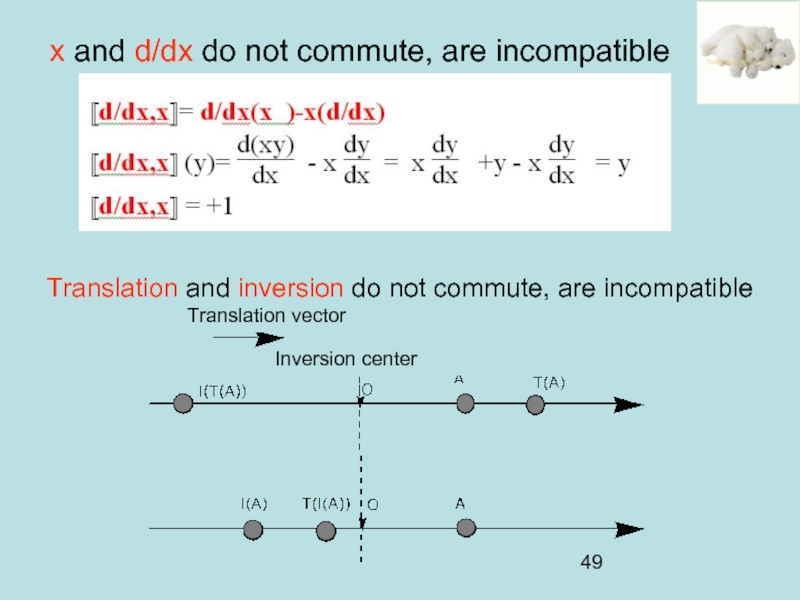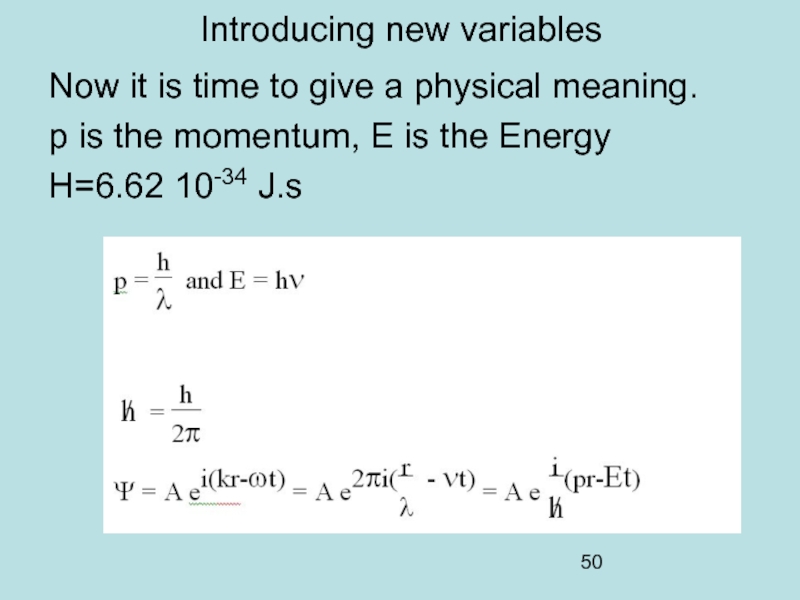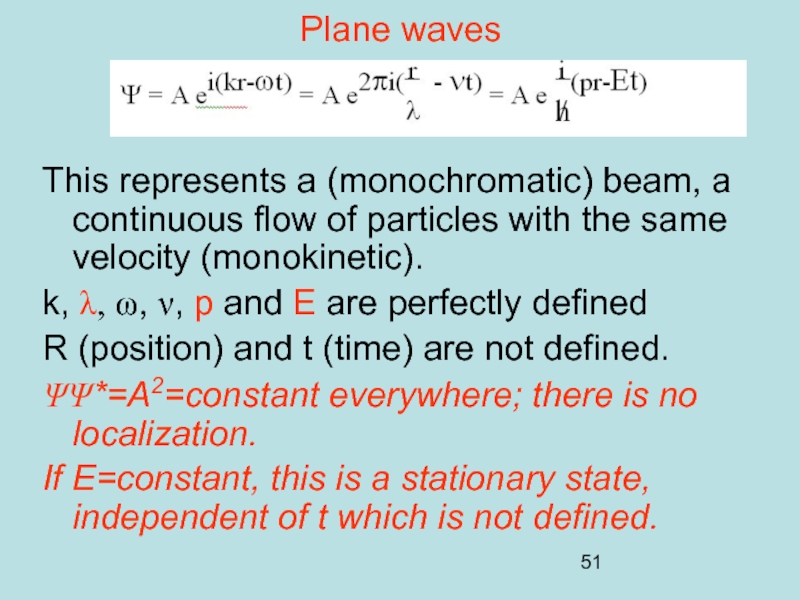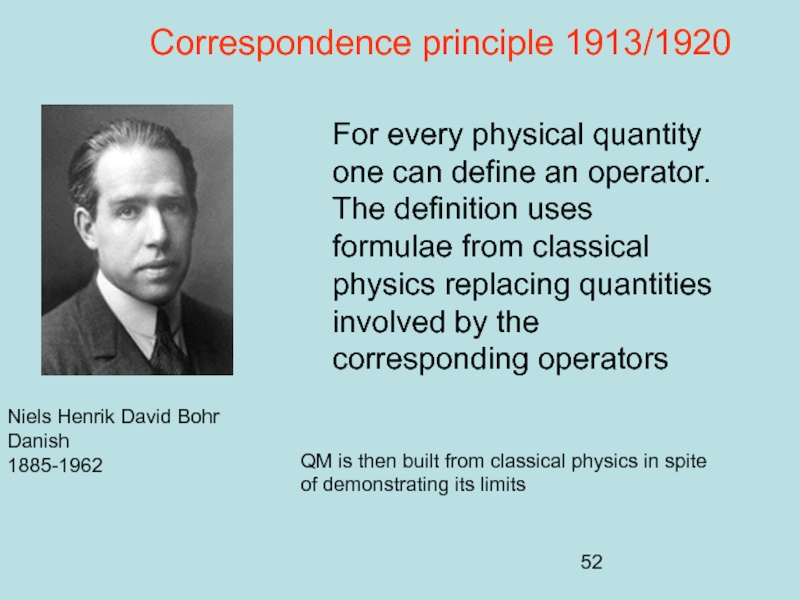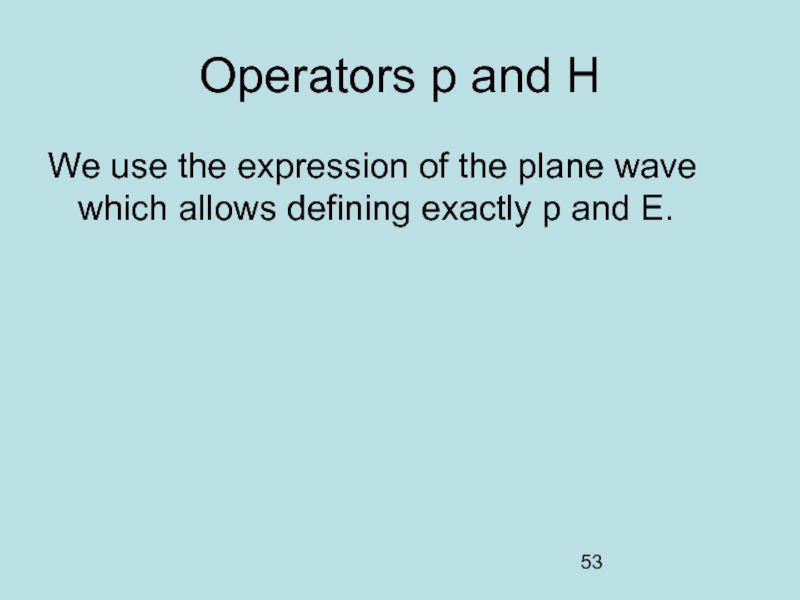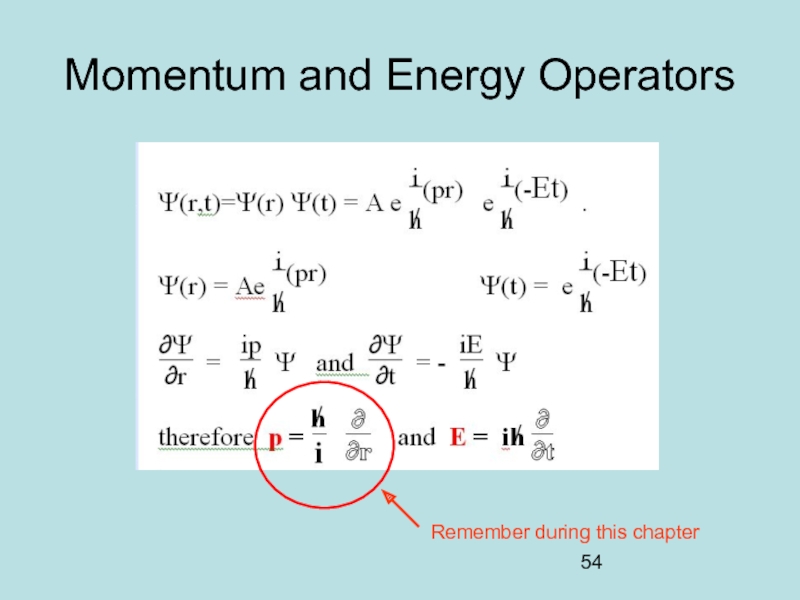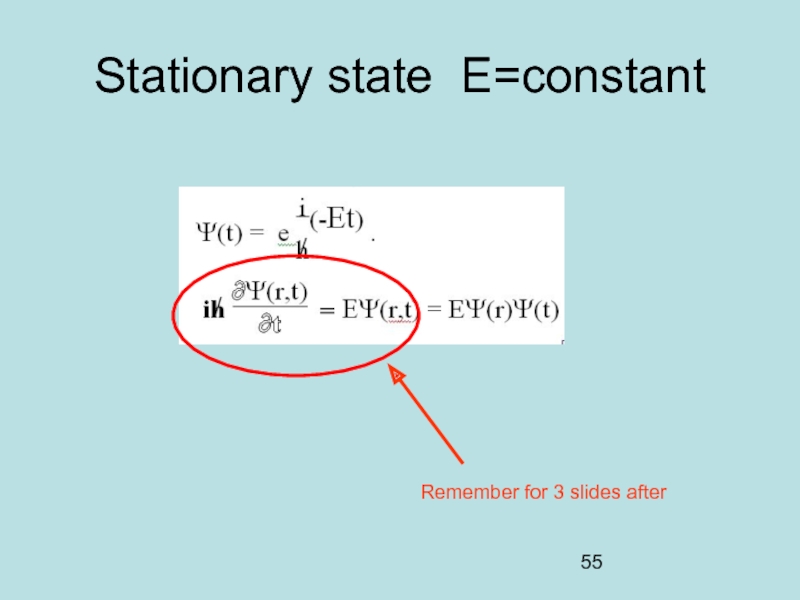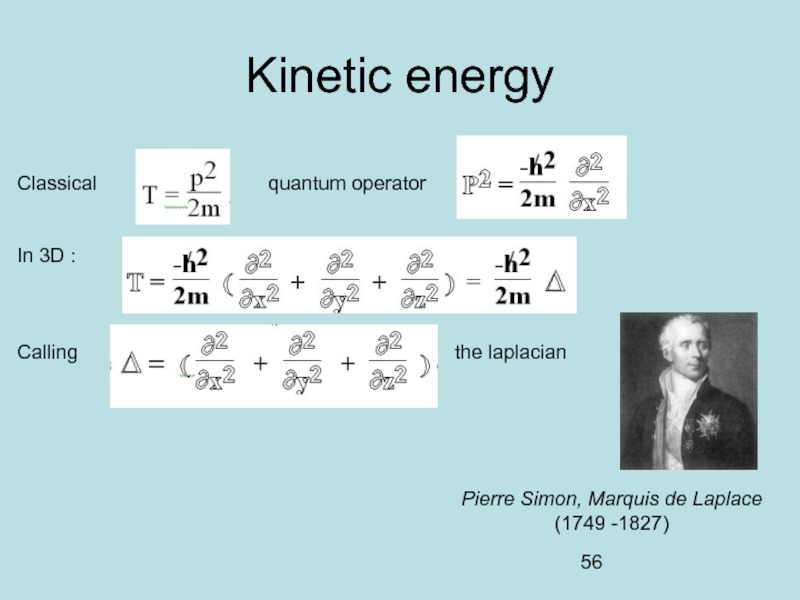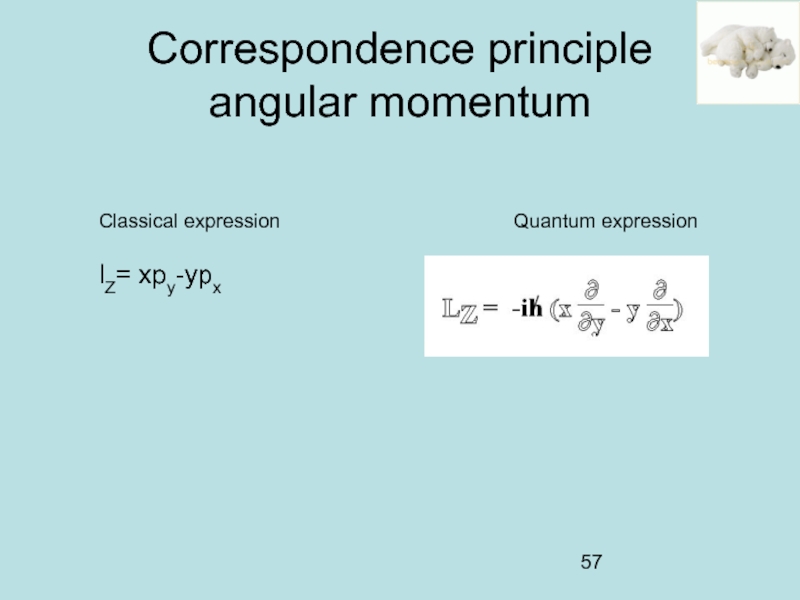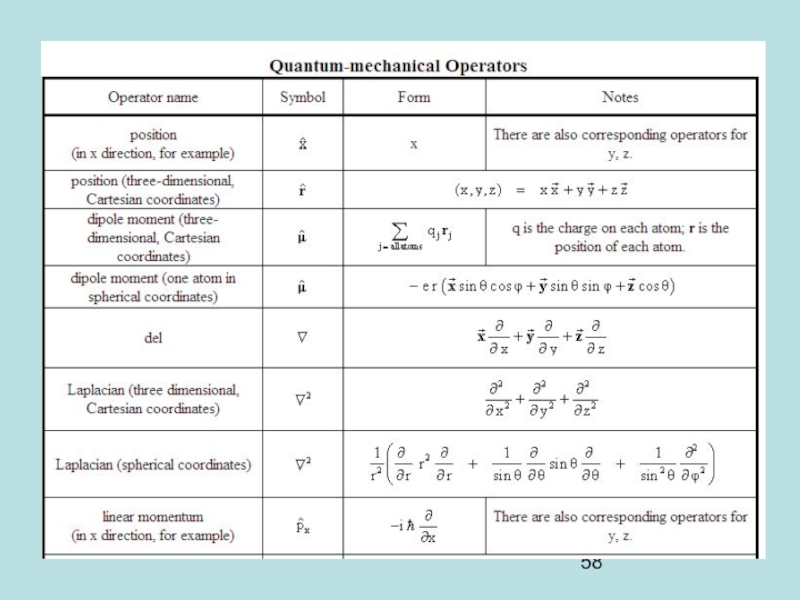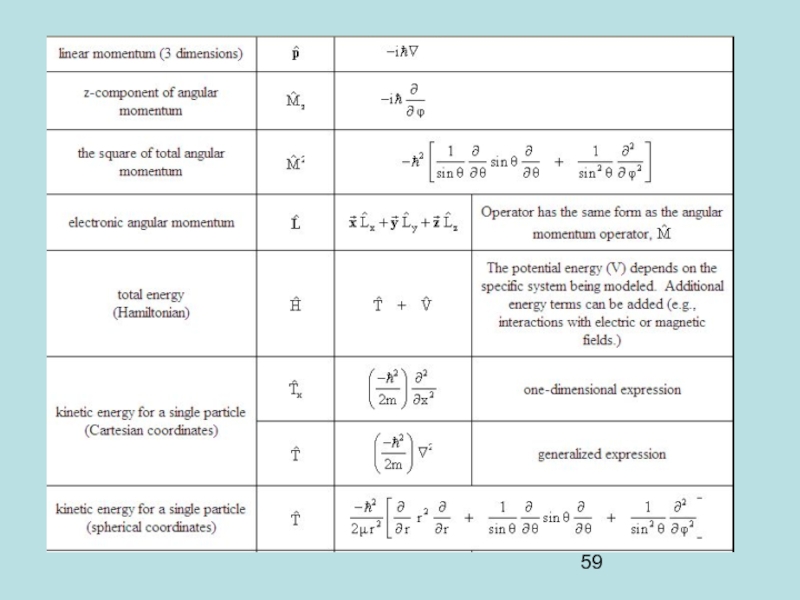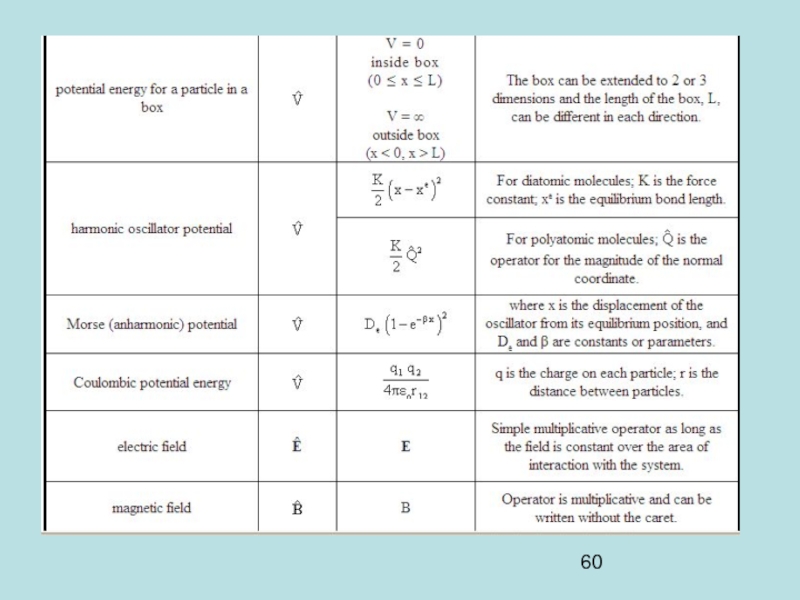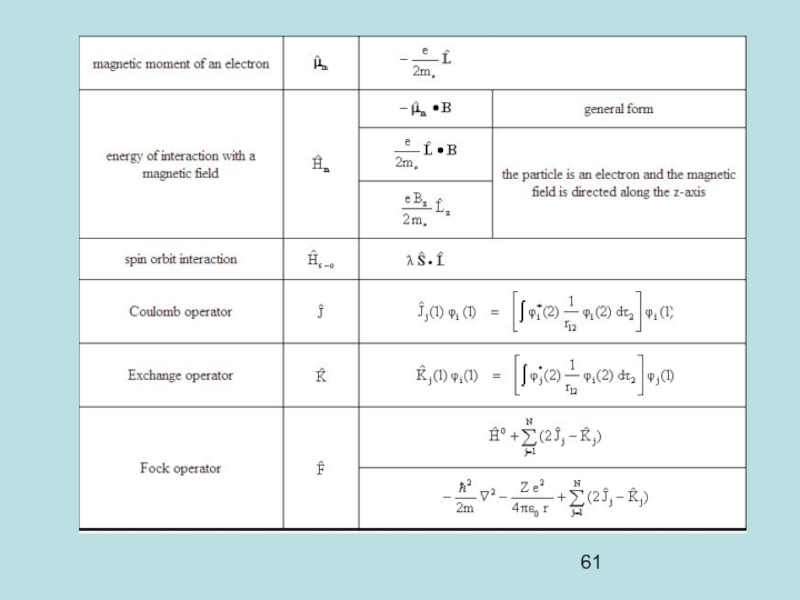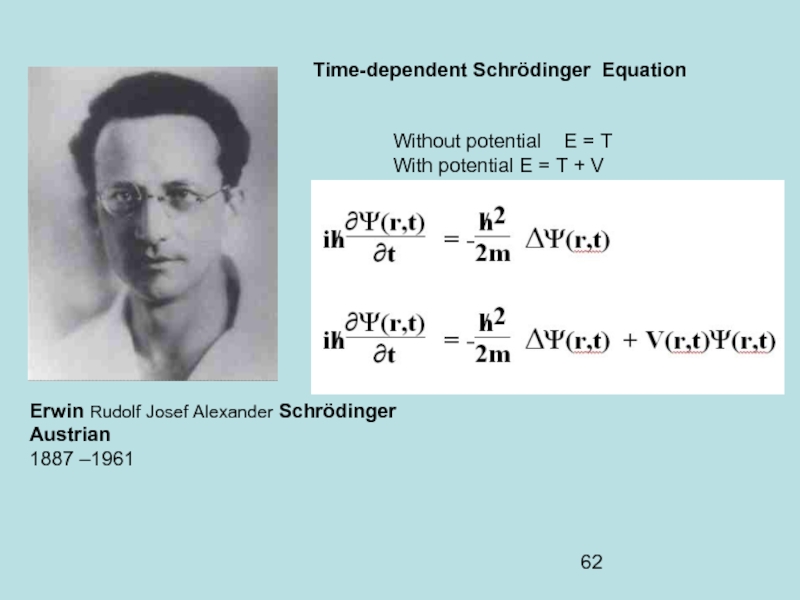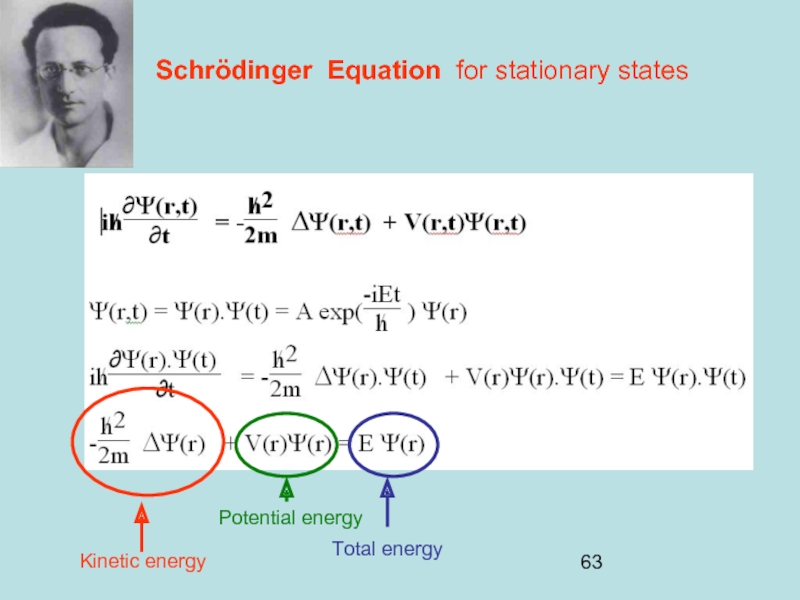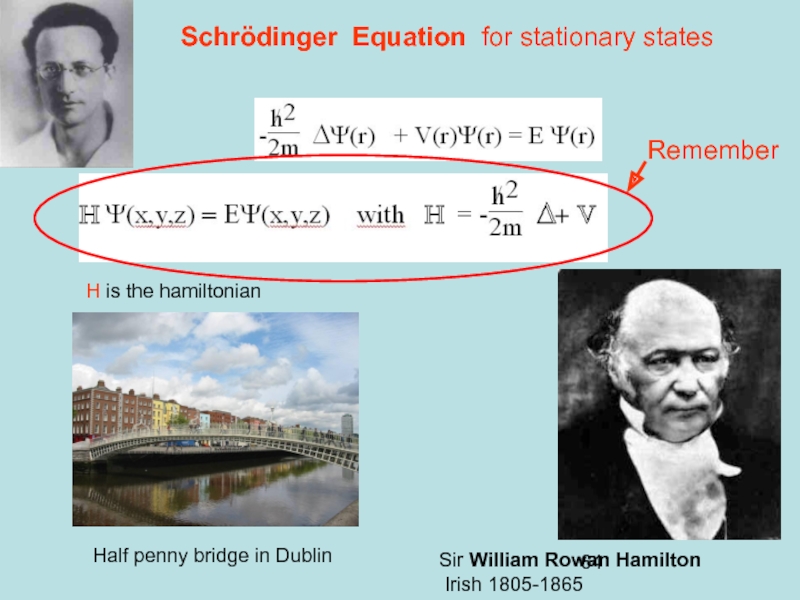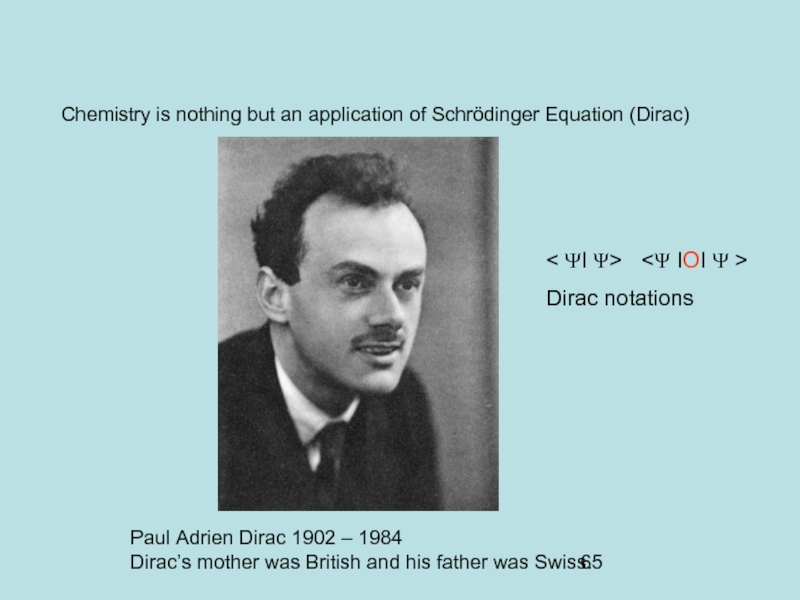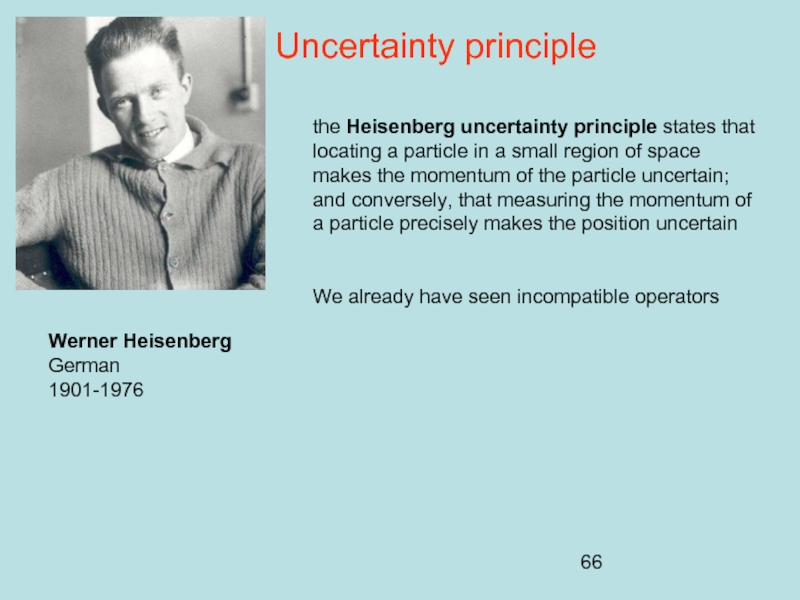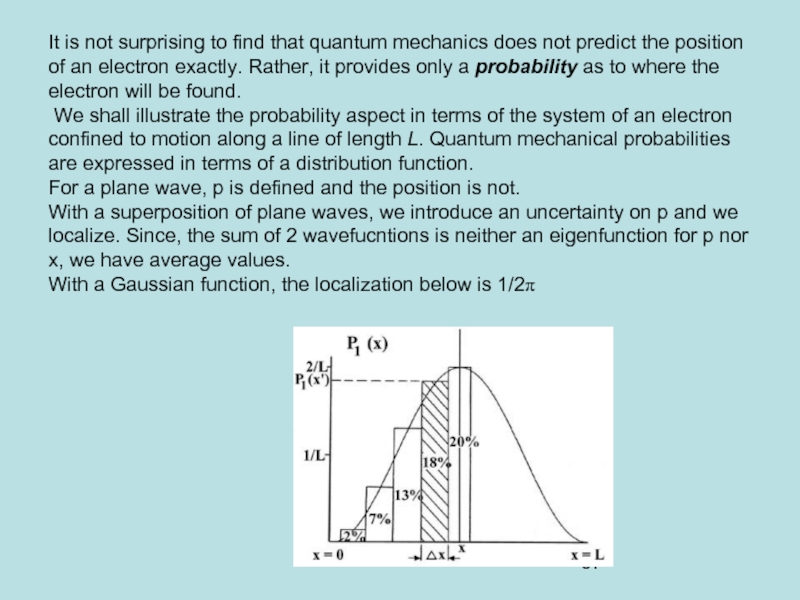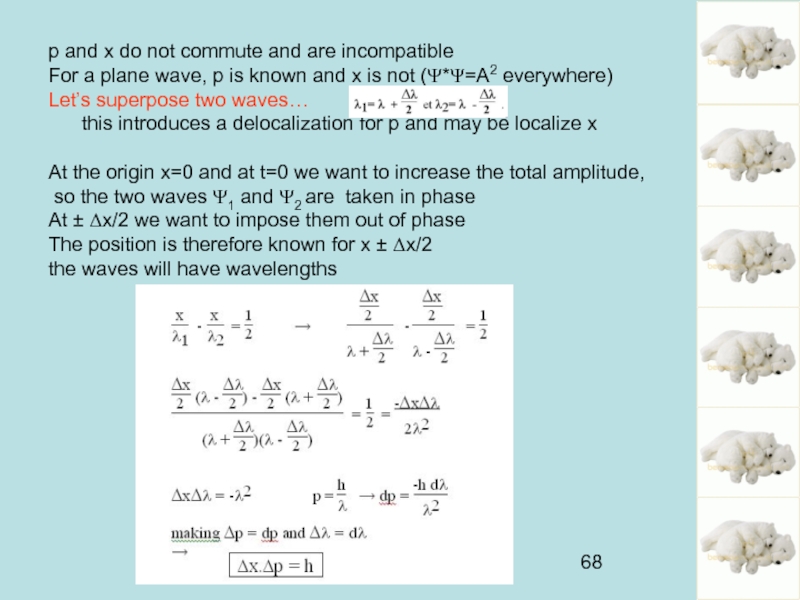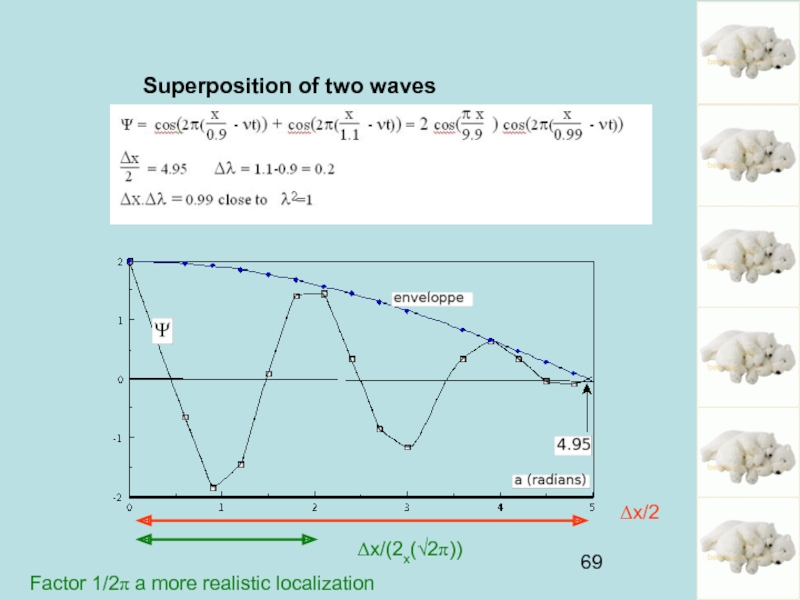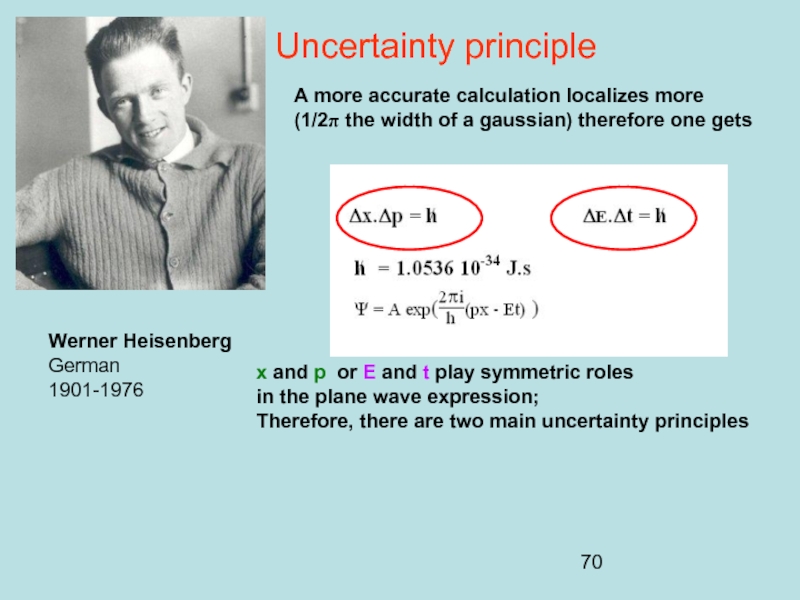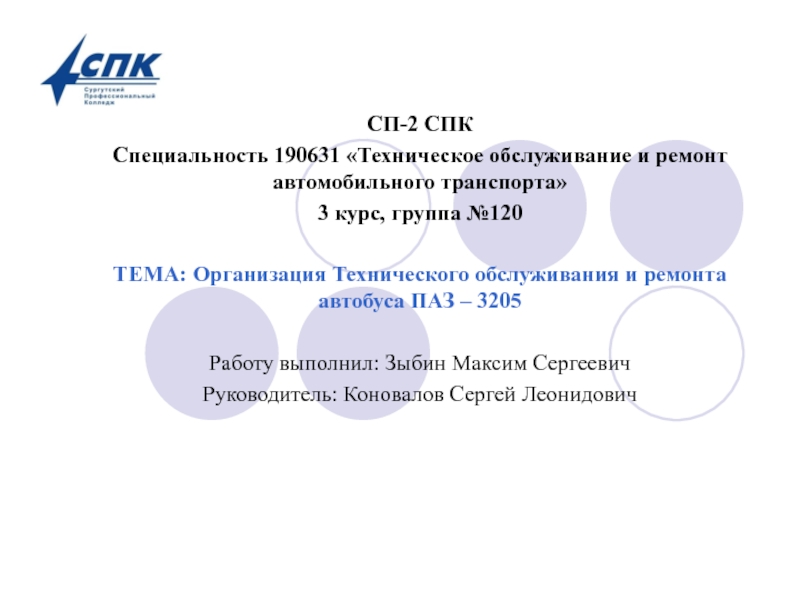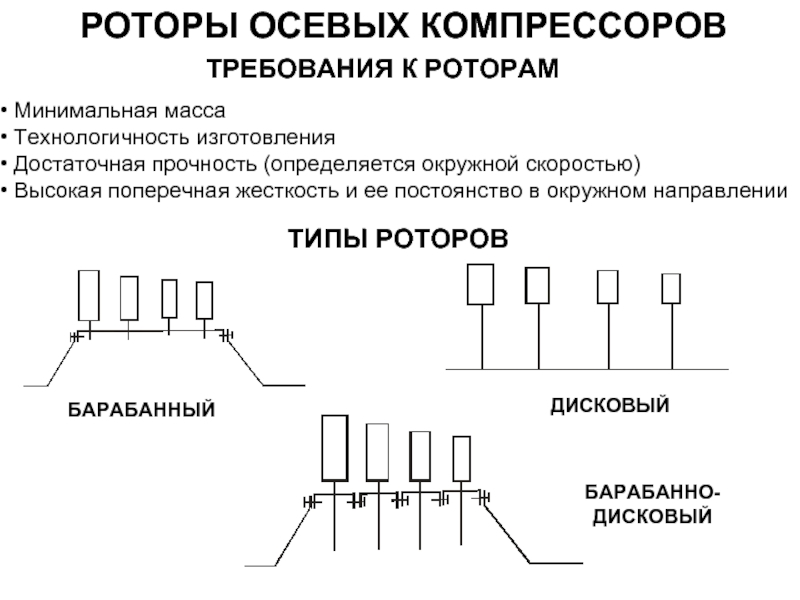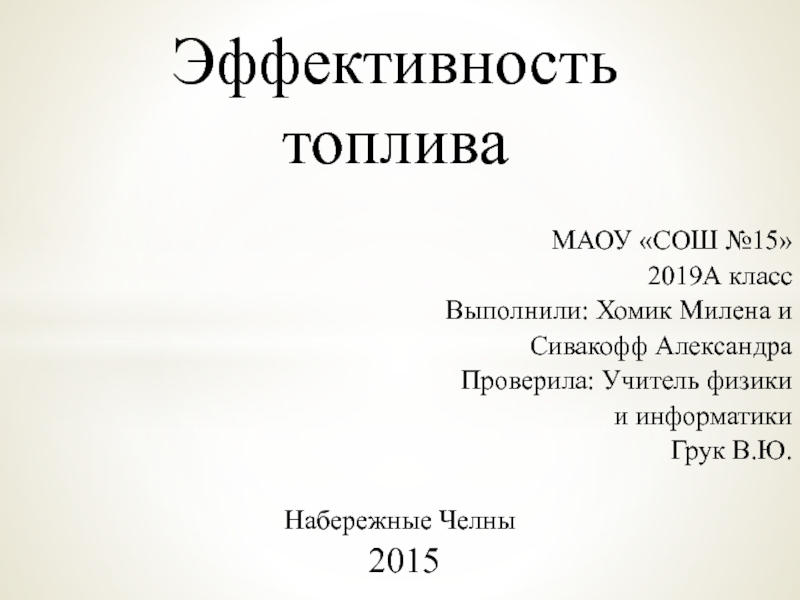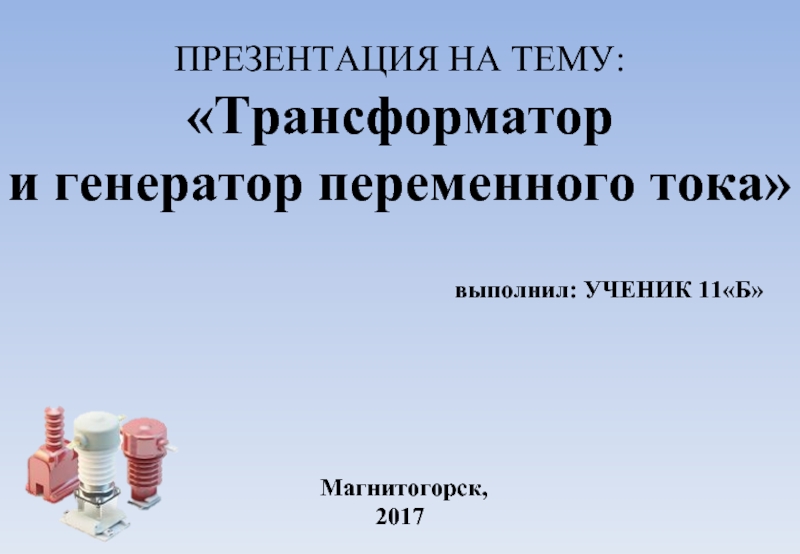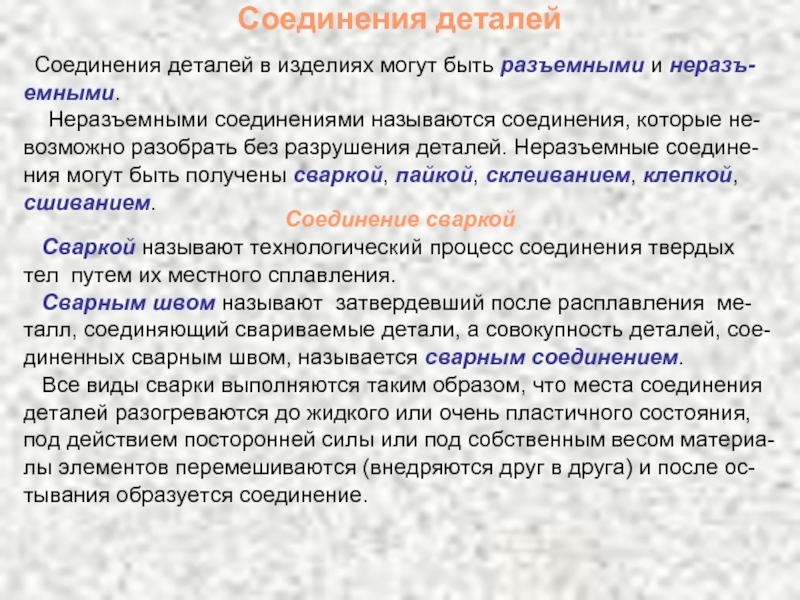- Главная
- Разное
- Дизайн
- Бизнес и предпринимательство
- Аналитика
- Образование
- Развлечения
- Красота и здоровье
- Финансы
- Государство
- Путешествия
- Спорт
- Недвижимость
- Армия
- Графика
- Культурология
- Еда и кулинария
- Лингвистика
- Английский язык
- Астрономия
- Алгебра
- Биология
- География
- Детские презентации
- Информатика
- История
- Литература
- Маркетинг
- Математика
- Медицина
- Менеджмент
- Музыка
- МХК
- Немецкий язык
- ОБЖ
- Обществознание
- Окружающий мир
- Педагогика
- Русский язык
- Технология
- Физика
- Философия
- Химия
- Шаблоны, картинки для презентаций
- Экология
- Экономика
- Юриспруденция
Introduction to Quantum Mechanic презентация
Содержание
- 1. Introduction to Quantum Mechanic
- 2. When you find this image,
- 3. The idea of duality is rooted in
- 4. Radiations, terminology
- 5. Interferences in
- 6. Phase speed or velocity
- 7. Introducing new variables At the moment, let
- 8. Introducing new variables At the moment, h
- 9. 2 different velocities, v and vϕ
- 10. If h is the Planck constant J.s
- 11. Robert Millikan (1910) showed that it
- 12. Gustav Kirchhoff (1860). The light emitted by
- 13. black-body radiation Classical Theory Fragmentation of the
- 14. Kirchhoff black-body radiation RED
- 15. black-body radiation Max Planck (1901) Göttingen Why
- 16. Quantum numbers In mathematics, a natural number
- 17. black-body radiation Max Planck (1901) Göttingen Why a decrease for small λ ? Quantification
- 18. black-body radiation, quantification Max Planck Steps
- 19. Max Planck
- 20. Johannes Rydberg 1888 Swedish Atomic Spectroscopy Absorption or Emission
- 21. Johannes Rydberg 1888 Swedish
- 22. Photoelectric Effect (1887-1905) discovered by Hertz in
- 23. Kinetic energy
- 24. Compton effect 1923 playing billiards assuming λ=h/p Arthur Holly Compton American 1892-1962
- 25. Davisson and Germer 1925 Clinton Davisson Lester
- 26. Wave-particle Equivalence. Compton Effect (1923). Electron
- 27. Thomas Young 1773 – 1829
- 28. Young's Double Slit Experiment Screen Mask with 2 slits
- 29. Young's Double Slit Experiment This is a
- 30. Young's Double Slit Experiment Assuming a single
- 31. Young's Double Slit Experiment There is no
- 32. Macroscopic world: A basket of cherries Many
- 33. Slot machine “one-arm bandit” After introducing a
- 34. de Broglie relation from relativity Popular expressions
- 35. de Broglie relation from relativity Application to
- 36. Max Planck Useful to remember to relate energy and wavelength
- 37. A New mathematical tool:
- 38. Wave functions describing one particle To represent
- 39. Operators associated to physical quantities We cannot
- 40. Slot machine (one-arm bandit) Introducing a coin,
- 41. Examples of operators in mathematics : P
- 42. Examples of operators in mathematics : A
- 43. Linearity The operators are linear: O (aΨ1+
- 44. Normalization An eigenfunction remains an eigenfunction when
- 45. Mean value If Ψ1 and Ψ2 are
- 46. Sum, product and commutation of operators (A+B)Ψ=AΨ+BΨ
- 47. Sum, product and commutation of operators not
- 48. Compatibility, incompatibility of operators not compatible operators
- 49. x and d/dx do not commute, are
- 50. Introducing new variables Now it is time
- 51. Plane waves This represents a (monochromatic) beam,
- 52. Niels Henrik David Bohr Danish 1885-1962
- 53. Operators p and H We use the
- 54. Momentum and Energy Operators Remember during this chapter
- 55. Stationary state E=constant Remember for 3 slides after
- 56. Kinetic energy Classical
- 57. Correspondence principle angular momentum Classical expression
- 62. Erwin Rudolf Josef Alexander Schrödinger Austrian
- 63. Schrödinger Equation for stationary states Kinetic energy Total energy Potential energy
- 64. Schrödinger Equation for stationary states H is
- 65. Chemistry is nothing but an application of
- 66. Uncertainty principle the Heisenberg uncertainty principle
- 67. It is not surprising to find that
- 68. p and x do not commute and
- 69. Superposition of two waves Δx/2 Δx/(2x(√2π)) Factor 1/2π a more realistic localization
- 70. Uncertainty principle Werner Heisenberg German 1901-1976
Слайд 1 Introduction to Quantum Mechanic
A) Radiation
B) Light is made of particles.
1) Black-body radiation (1860-1901)
2) Atomic Spectroscopy (1888-)
3) Photoelectric Effect (1887-1905)
C) Wave–particle duality
1) Compton Effect (1923).
2) Electron Diffraction Davisson and Germer (1925).
3) Young's Double Slit Experiment
D) Louis de Broglie relation for a photon from relativity
E) A new mathematical tool: Wavefunctions and operators
F) Measurable physical quantities and associated operators - Correspondence principle
G) The Schrödinger Equation (1926)
H) The Uncertainty principle
Слайд 3The idea of duality is rooted in a debate over the
Christiaan Huygens
Dutch 1629-1695
light consists of waves
Sir Isaac Newton
1643 1727
light consists of particles
Слайд 7Introducing new variables
At the moment, let consider this just a formal
and
we obtain
Слайд 8Introducing new variables
At the moment, h is a simple constant
Later on,
Then
Слайд 10If h is the Planck constant J.s
Then
Louis de BROGLIE
French
(1892-1987)
Max Planck
Göttingen
Слайд 11 Robert Millikan (1910) showed that it was quantified.
Rutherford (1911) showed
Soon after the
electron discovery in 1887
- J. J. Thomson (1887) Some negative part could be extracted from the atoms
Слайд 12Gustav Kirchhoff (1860). The light emitted by a black body is
black-body radiation
At room temperature, black bodies emit IR light, but as the temperature increases past a few hundred degrees Celsius, black bodies start to emit at visible wavelengths, from red, through orange, yellow, and white before ending up at blue, beyond which the emission includes increasing amounts of UV
RED WHITE
Small ν Large ν
Shift of ν
Слайд 13black-body radiation
Classical Theory
Fragmentation of the surface.
One large area (Small λ Large
Vibrations associated to the size, N2 or N3
Слайд 14Kirchhoff
black-body radiation
RED
Small ν Large ν
Shift of ν
Radiation is emitted when a solid after receiving energy goes back to the most stable state (ground state). The energy associated with the radiation is the difference in energy between these 2 states. When T increases, the average E*Mean is higher and intensity increases.
E*Mean- E = kT.
k is Boltzmann constant (k= 1.38 10-23 Joules K-1).
Слайд 15black-body radiation
Max Planck (1901)
Göttingen
Why a decrease for small λ ? Quantification
Numbering
Слайд 16Quantum numbers
In mathematics, a natural number (also called counting number) has
Слайд 18black-body radiation,
quantification
Max Planck
Steps too hard to climb
Pyramid nowadays Pyramid under construction
Слайд 21Johannes Rydberg 1888
Swedish
IR
VISIBLE
UV
Atomic Spectroscopy
Absorption or Emission
Emission
-R/12
-R/22
-R/32
-R/42
-R/52
-R/62
-R/72
Quantum numbers n, levels are
Слайд 22Photoelectric Effect (1887-1905)
discovered by Hertz in 1887 and explained in 1905
Heinrich HERTZ
(1857-1894)
Albert EINSTEIN
(1879-1955)
Слайд 25Davisson and Germer 1925
Clinton Davisson
Lester Germer
In 1927
Diffraction is similarly observed using
Bragg law is verified assuming λ=h/p
Слайд 26Wave-particle Equivalence.
Compton Effect (1923).
Electron Diffraction Davisson and Germer (1925)
Young's Double Slit
In physics and chemistry, wave–particle duality is the concept that all matter and energy exhibits both wave-like and particle-like properties. A central concept of quantum mechanics, duality, addresses the inadequacy of classical concepts like "particle" and "wave" in fully describing the behavior of small-scale objects. Various interpretations of quantum mechanics attempt to explain this apparent paradox.
Wave–particle duality
Слайд 27Thomas Young 1773 – 1829
English, was born into a
At age 2, he could read.
At 7, he learned Latin, Greek and maths.
At 12, he spoke Hebrew, Persian and could handle optical instruments.
At 14, he spoke Arabic, French, Italian and Spanish, and soon the Chaldean Syriac. "…
He is a PhD to 20 years "gentleman, accomplished flute player and minstrel (troubadour). He is reported dancing above a rope."
He worked for an insurance company, continuing research into the structure of the retina, astigmatism ...
He is the rival Champollion to decipher hieroglyphics.
He is the first to read the names of Ptolemy and Cleopatra which led him to propose a first alphabet of hieroglyphic scriptures (12 characters).
Слайд 29Young's Double Slit Experiment
This is a typical experiment showing the wave
What happens when we decrease the light intensity ?
If radiation = particles, individual photons reach one spot and there will be no interferences
If radiation ≠ particles there will be no spots on the screen
The result is ambiguous
There are spots
The superposition of all the impacts make interferences
Слайд 30Young's Double Slit Experiment
Assuming a single electron each time
What means interference
What is its trajectory?
If it goes through F1, it should ignore the presence of F2
Screen
Mask with 2 slits
Слайд 31Young's Double Slit Experiment
There is no possibility of knowing through which
If we measure the crossing through F1, we have to place a screen behind.
Then it does not go to the final screen.
We know that it goes through F1 but we do not know where it would go after.
These two questions are not compatible
Screen
Mask with 2 slits
Two important differences with classical physics:
measurement is not independent from observer
trajectories are not defined; hν goes through F1 and F2 both! or through them with equal probabilities!
Слайд 32Macroscopic world:
A basket of cherries
Many of them (identical)
We can see
Taking one has negligible effect
Cherries are both red and good
Microscopic world:
A single cherry
Either we look at it without eating
It is red
Or we eat it, it is good
You can not try both at the same time
The cherry could not be good and red at the same time
Слайд 33Slot machine “one-arm bandit”
After introducing a coin, you have 0 coin
A measure of the profit has been made: profit = X
Слайд 34de Broglie relation from relativity
Popular expressions of relativity:
m0 is the mass
E like to express E(m) as E(p) with p=mv
Ei + T + Erelativistic + ….
Слайд 37A New mathematical tool:
Each particle may be described by a wave function Ψ(x,y,z,t), real or complex,
having a single value when position (x,y,z) and time (t) are defined.
If it is not time-dependent, it is called stationary.
The expression Ψ=Aei(pr-Et) does not represent one molecule but a flow of particles: a plane wave
Слайд 38Wave functions describing one particle
To represent a single particle Ψ(x,y,z) that
In QM, a particle is not localized but has a probability to be in a given volume:
dP= Ψ* Ψ dV is the probability of finding the particle in the volume dV.
Around one point in space, the density of probability is dP/dV= Ψ* Ψ
Ψ has the dimension of L-1/3
Integration in the whole space should give one
Ψ is said to be normalized.
Слайд 39Operators associated to physical quantities
We cannot use functions (otherwise we would
Any physical quantity is associated with an operator. An operator O is “the recipe to transform Ψ into Ψ’ ”
We write: O Ψ = Ψ’
If O Ψ = oΨ (o is a number, meaning that O does not modify Ψ, just a scaling factor), we say that Ψ is an eigenfunction of O and o is the eigenvalue. We have solved the wave equation O Ψ = oΨ by finding simultaneously Ψ and o that satisfy the equation.
o is the measure of O for the particle in the state described by Ψ.
Слайд 40Slot machine (one-arm bandit)
Introducing a coin, you have 0 coin or
A measure of the profit has been made: profit = X
O is a Vending machine (cans)
Introducing a coin, you get one can.
No measure of the gain is made unless you sell the can (return to coins)
Слайд 41Examples of operators in mathematics : P parity
Even function : no
Odd function : f changes sign after x → -x
y=x2 is even
y=x3 is odd
y= x2 + x3 has no parity: P(x2 + x3) = x2 - x3
Pf(x) = f(-x)
Слайд 44Normalization
An eigenfunction remains an eigenfunction when multiplied by a constant
O(λΨ)= o(λΨ)
Dirac notations <ΨIΨ>
Слайд 45Mean value
If Ψ1 and Ψ2 are associated with the same eigenvalue
If not O(aΨ1 +bΨ2)=o1(aΨ1 )+o2(bΨ2)
we define ō = (a2o1+b2o2)/(a2+b2)
Dirac notations
Слайд 46Sum, product and commutation of operators
(A+B)Ψ=AΨ+BΨ (AB)Ψ=A(BΨ)
operators
wavefunctions
eigenvalues
Слайд 47Sum, product and commutation of operators
not compatible
operators
[A,C]=AC-CA≠0
[A,B]=AB-BA=0
[B,C]=BC-CB=0
Слайд 48Compatibility, incompatibility of operators
not compatible
operators
[A,C]=AC-CA≠0
[A,B]=AB-BA=0
[B,C]=BC-CB=0
When operators commute, the physical quantities may
When operators do not commute, the physical quantities can not be simultaneously defined (incompatibility)
compatible
operators
Слайд 49x and d/dx do not commute, are incompatible
Translation and inversion do
Translation vector
Inversion center
Слайд 50Introducing new variables
Now it is time to give a physical meaning.
p
H=6.62 10-34 J.s
Слайд 51Plane waves
This represents a (monochromatic) beam, a continuous flow of particles
k, λ, ω, ν, p and E are perfectly defined
R (position) and t (time) are not defined.
ΨΨ*=A2=constant everywhere; there is no localization.
If E=constant, this is a stationary state, independent of t which is not defined.
Слайд 52Niels Henrik David Bohr
Danish
1885-1962
Correspondence principle 1913/1920
For every physical quantity
QM is then built from classical physics in spite of demonstrating its limits
Слайд 53Operators p and H
We use the expression of the plane wave
Слайд 56Kinetic energy
Classical
In 3D :
Calling the laplacian
Pierre Simon, Marquis de Laplace
(1749 -1827)
Слайд 62Erwin Rudolf Josef Alexander Schrödinger
Austrian
1887 –1961
Without potential E
With potential E = T + V
Time-dependent Schrödinger Equation
Слайд 64Schrödinger Equation for stationary states
H is the hamiltonian
Sir William Rowan Hamilton
Irish 1805-1865
Half penny bridge in Dublin
Remember
Слайд 65Chemistry is nothing but an application of Schrödinger Equation (Dirac)
Paul Adrien
Dirac’s mother was British and his father was Swiss.
< ΨI Ψ> <Ψ IOI Ψ >
Dirac notations
Слайд 66Uncertainty principle
the Heisenberg uncertainty principle states that locating a particle
We already have seen incompatible operators
Werner Heisenberg
German
1901-1976
Слайд 67It is not surprising to find that quantum mechanics does not
We shall illustrate the probability aspect in terms of the system of an electron confined to motion along a line of length L. Quantum mechanical probabilities are expressed in terms of a distribution function.
For a plane wave, p is defined and the position is not.
With a superposition of plane waves, we introduce an uncertainty on p and we localize. Since, the sum of 2 wavefucntions is neither an eigenfunction for p nor x, we have average values.
With a Gaussian function, the localization below is 1/2π
Слайд 68p and x do not commute and are incompatible
For a plane
Let’s superpose two waves…
this introduces a delocalization for p and may be localize x
At the origin x=0 and at t=0 we want to increase the total amplitude,
so the two waves Ψ1 and Ψ2 are taken in phase
At ± Δx/2 we want to impose them out of phase
The position is therefore known for x ± Δx/2
the waves will have wavelengths
Слайд 70Uncertainty principle
Werner Heisenberg
German
1901-1976
A more accurate calculation localizes more
(1/2π the
x and p or E and t play symmetric roles
in the plane wave expression;
Therefore, there are two main uncertainty principles
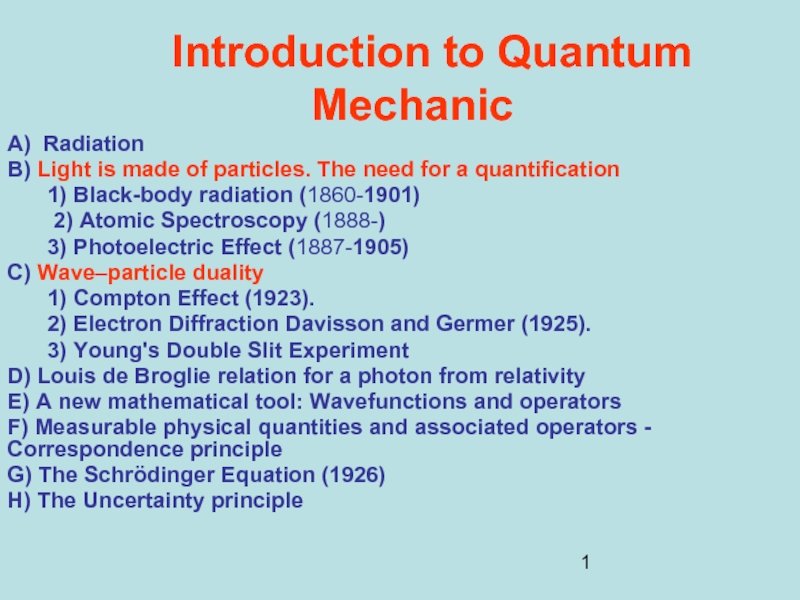

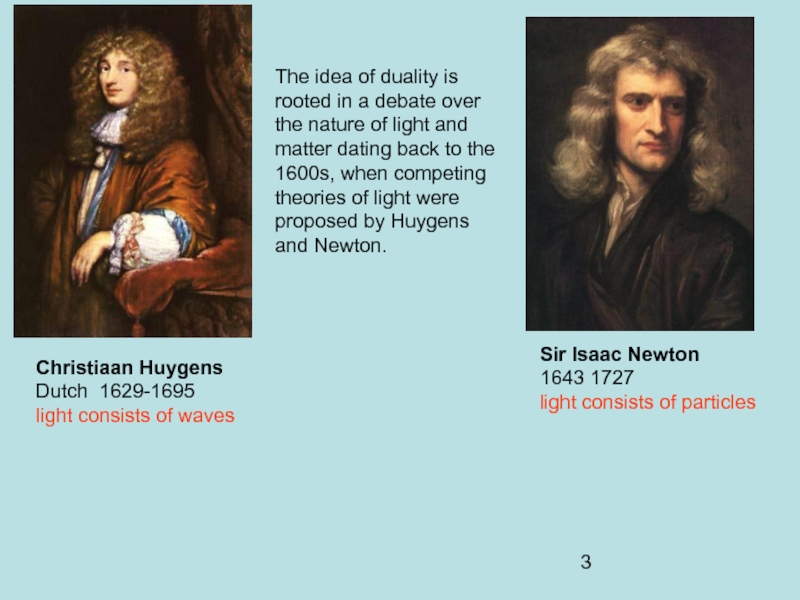
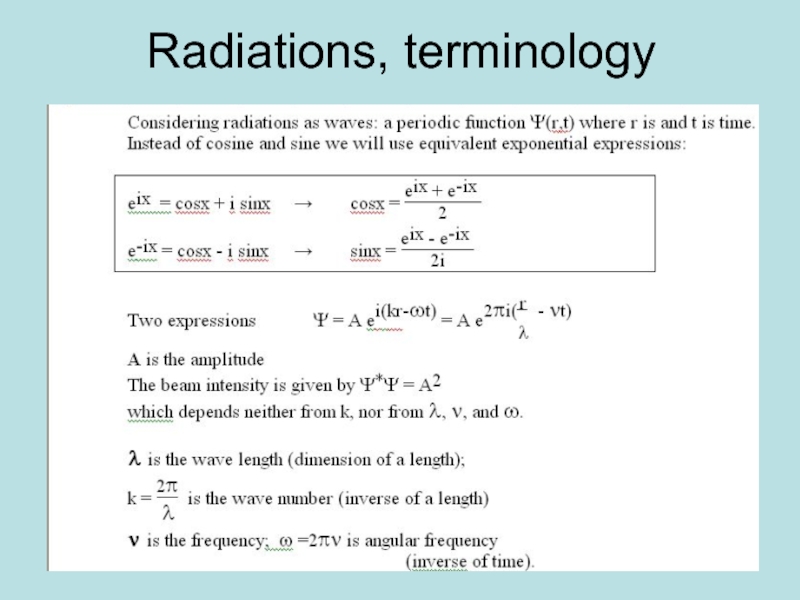

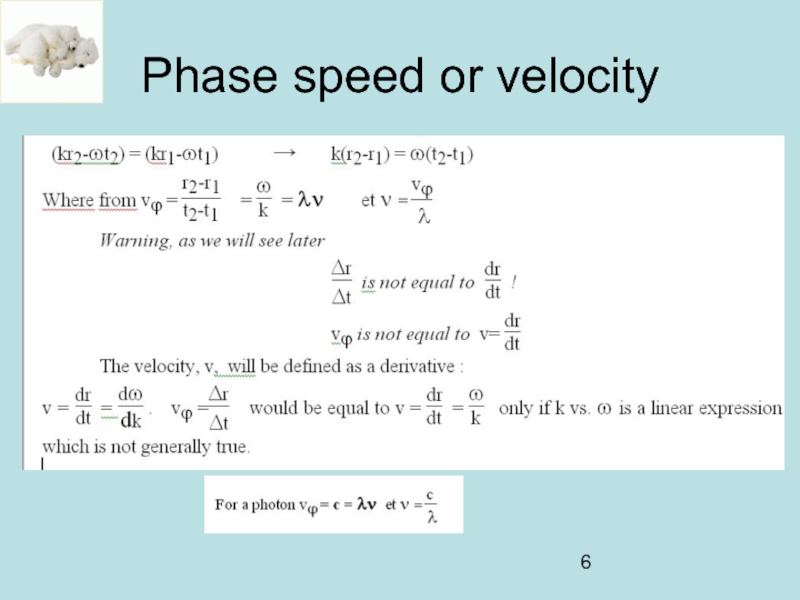
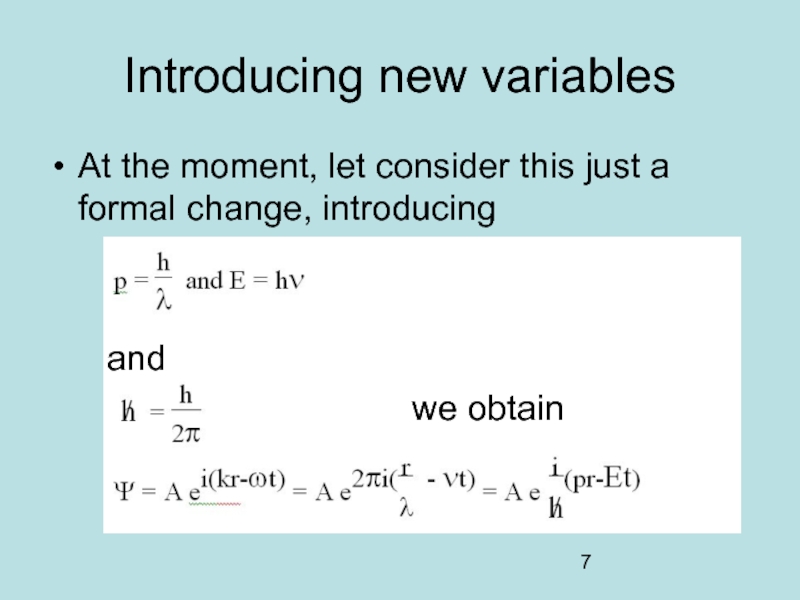
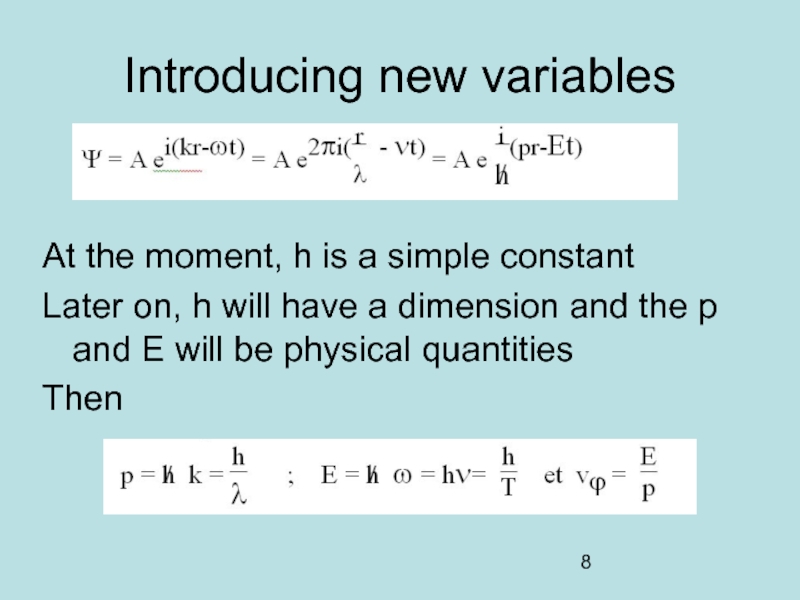
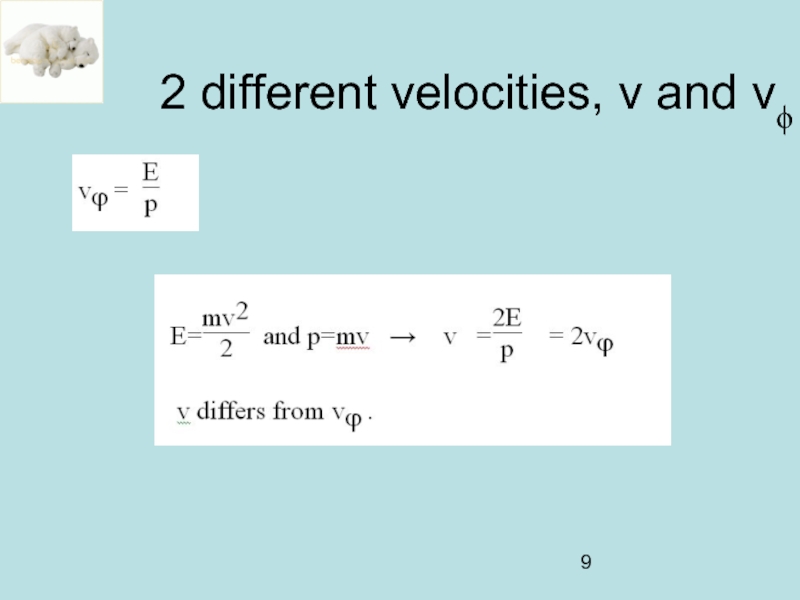
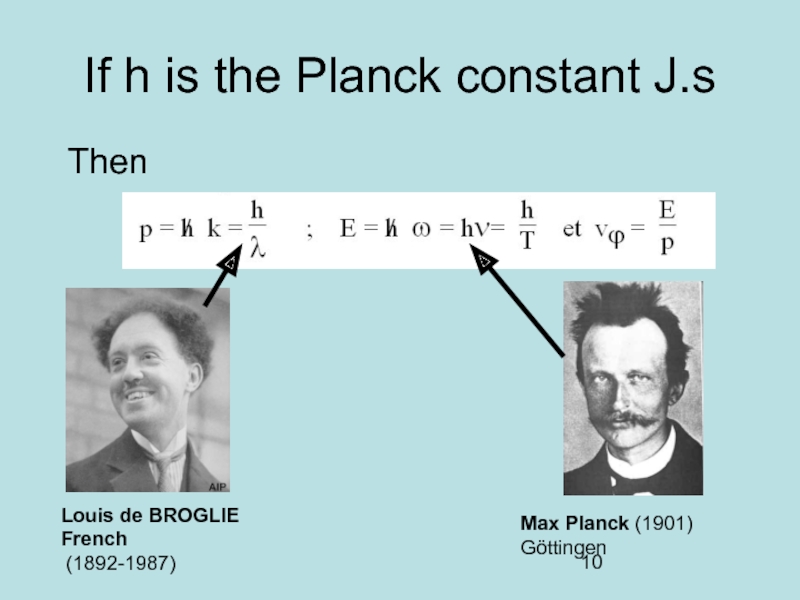
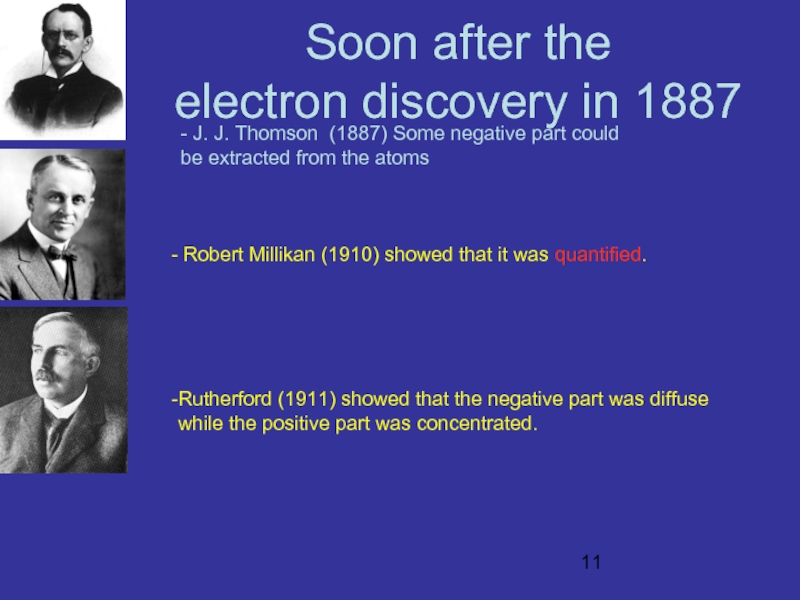
![Gustav Kirchhoff (1860). The light emitted by a black body is called black-body radiation]black-body radiationAt](/img/tmb/2/163699/7f9854030c19cbfef394cbdc6d278c74-800x.jpg)
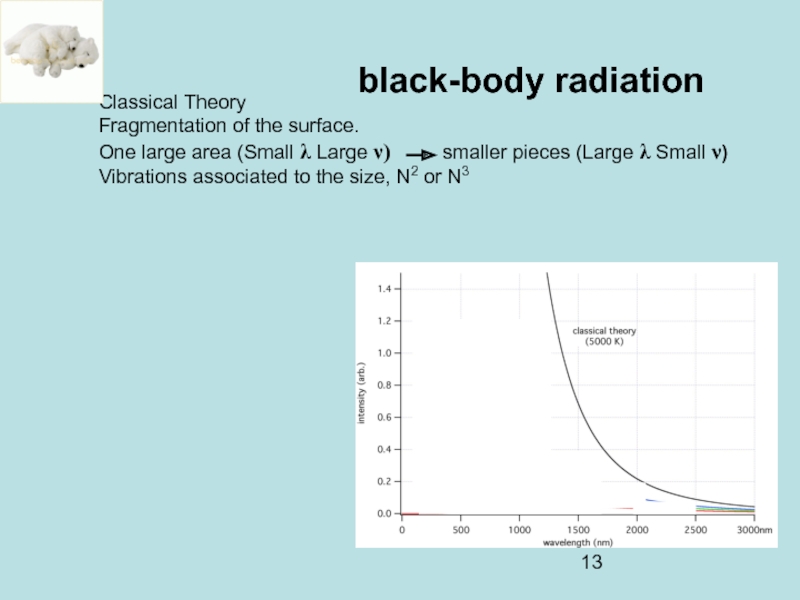
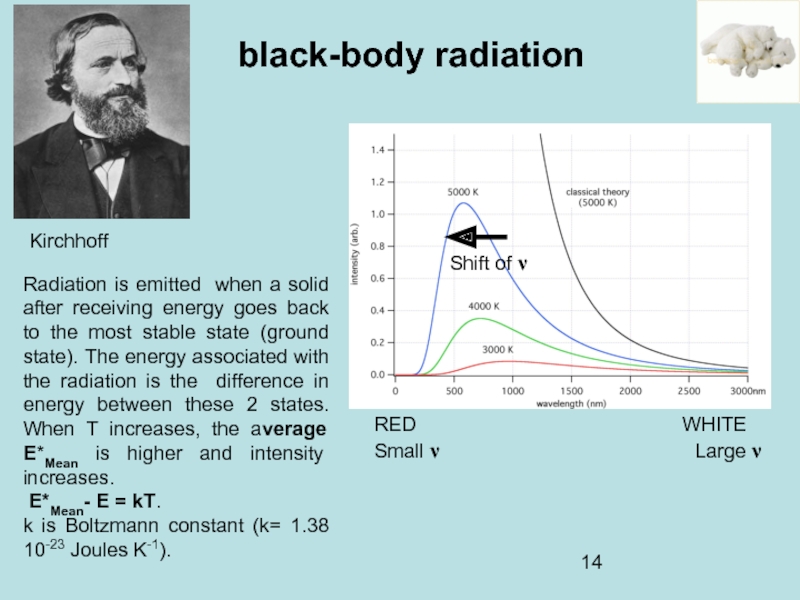
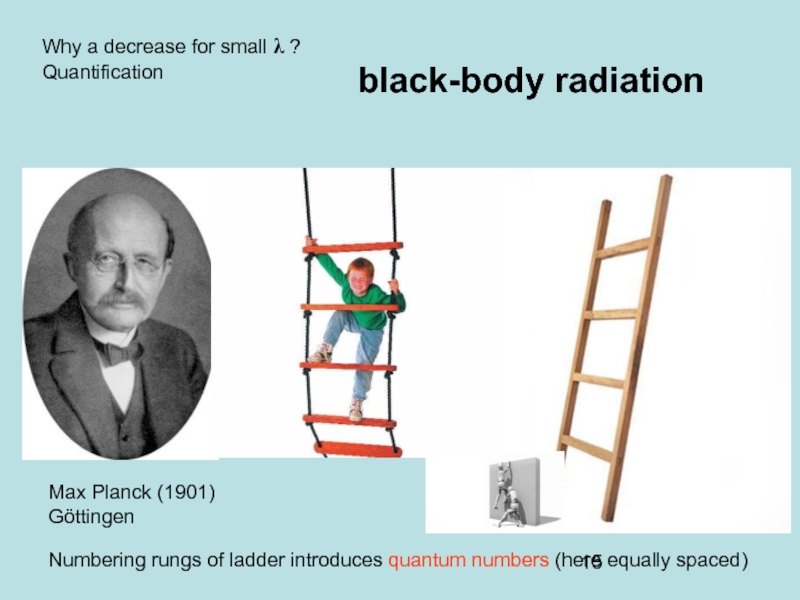
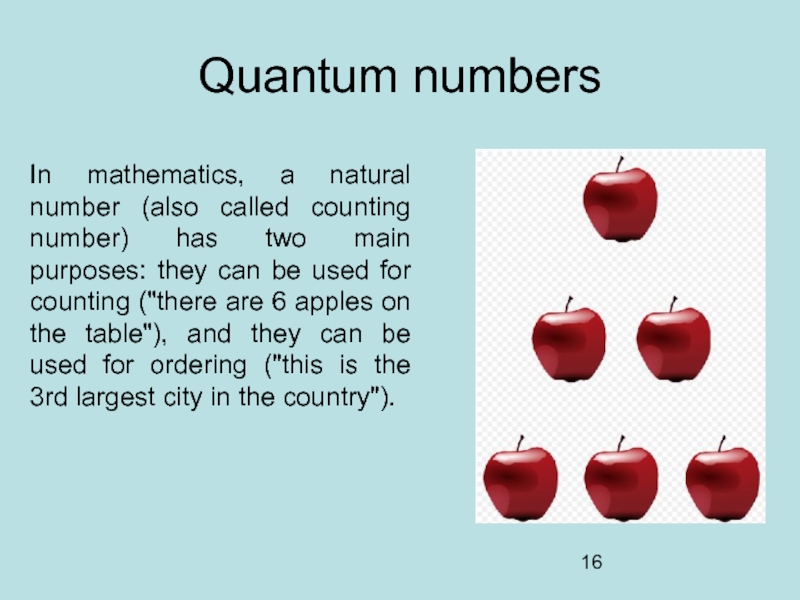
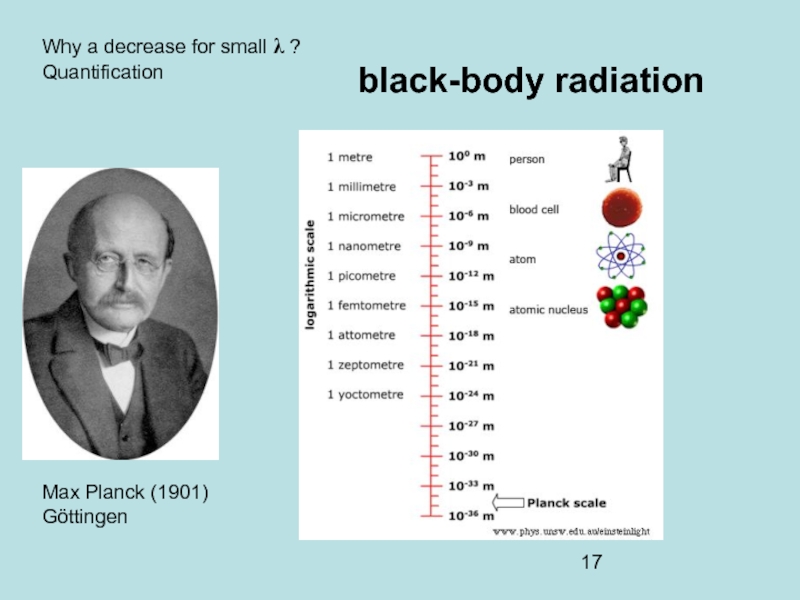
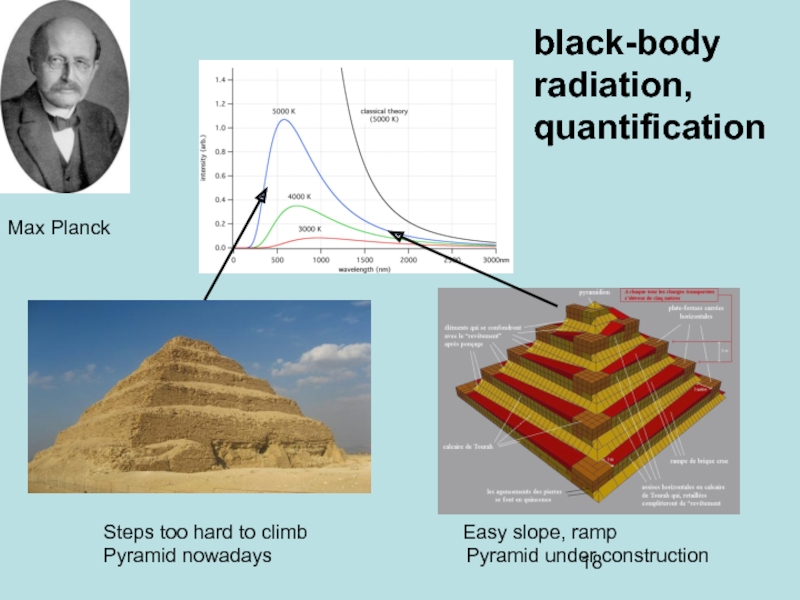
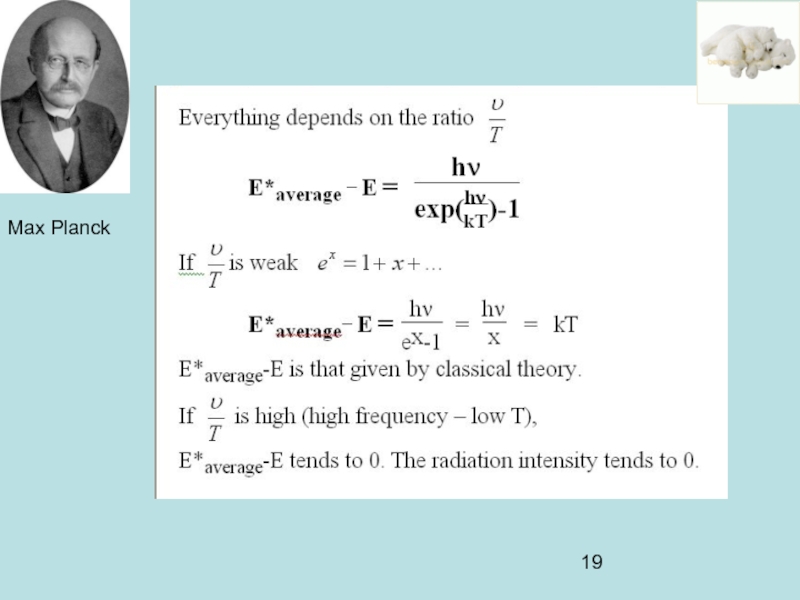
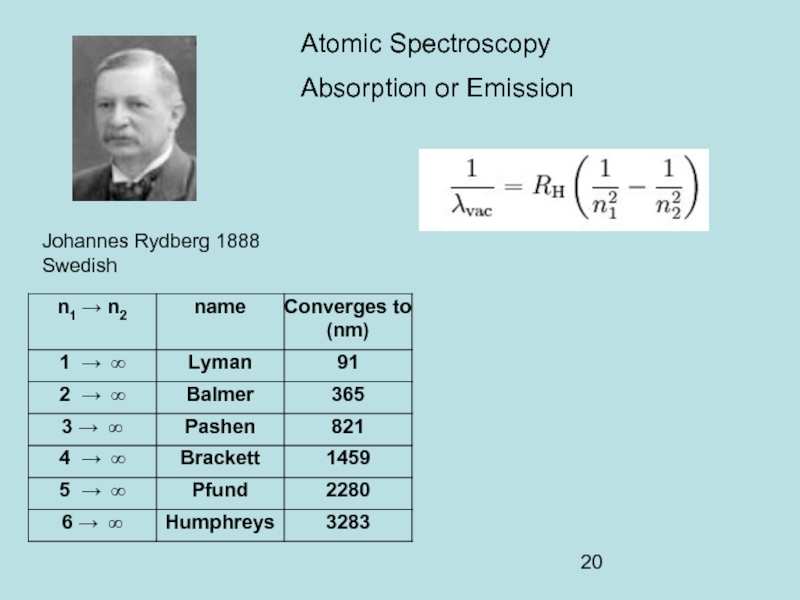
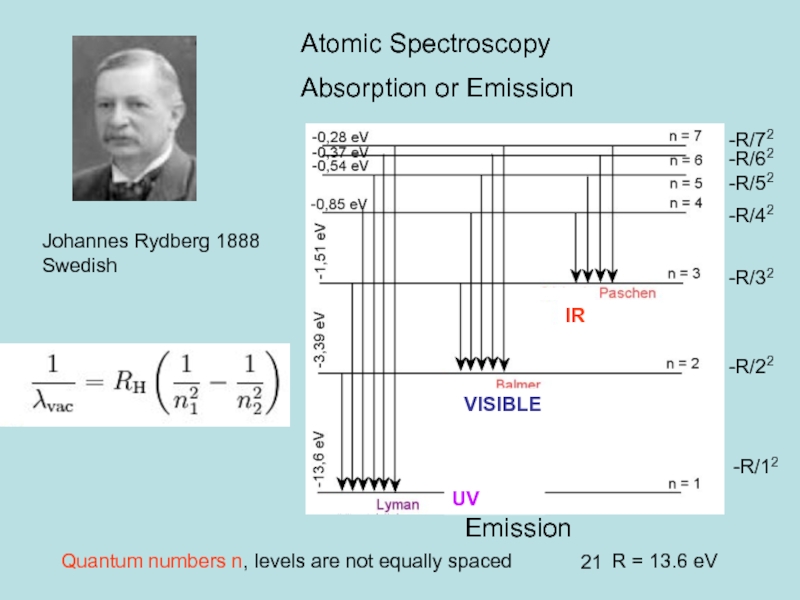
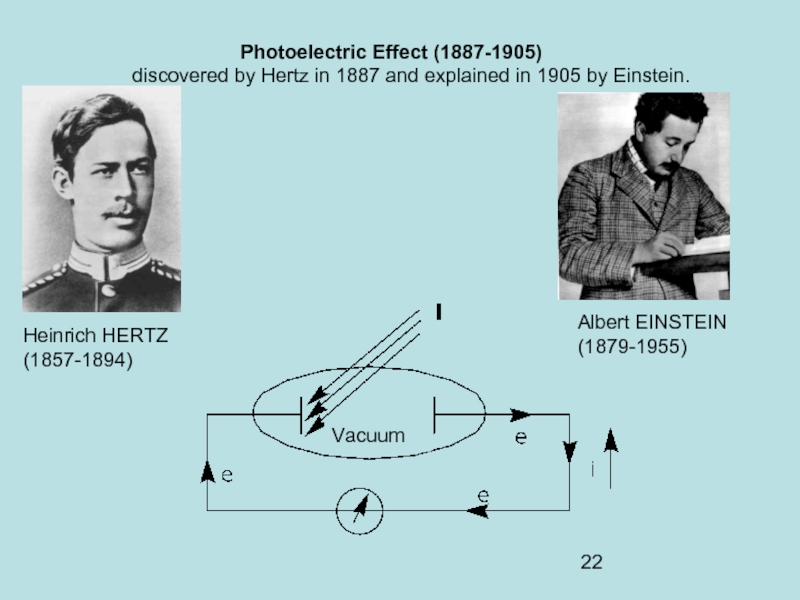
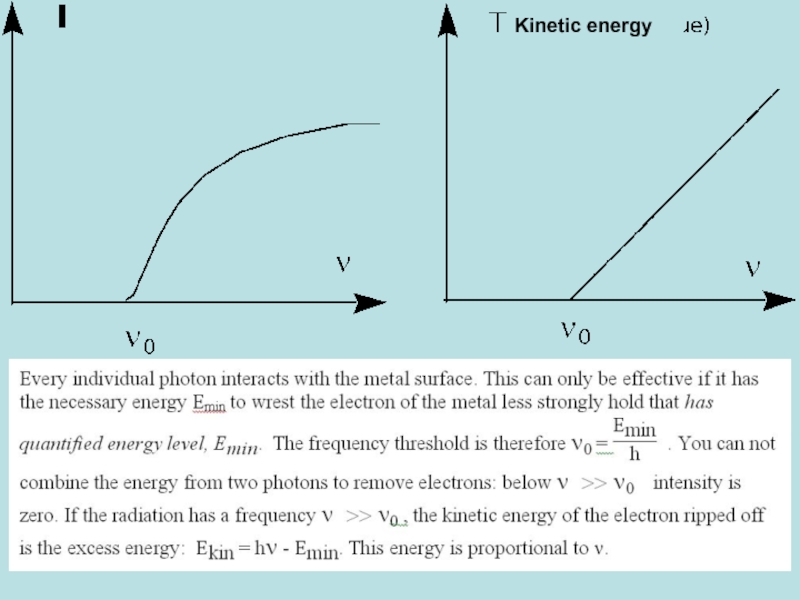
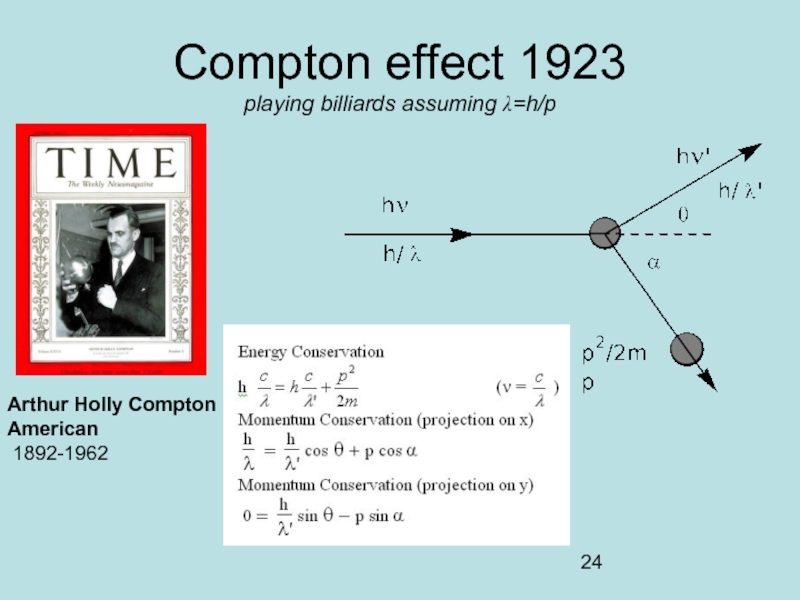
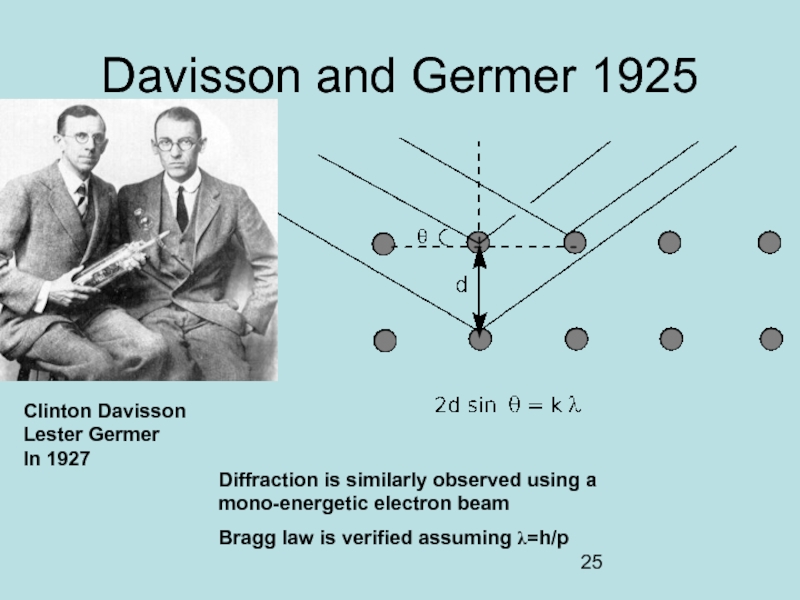
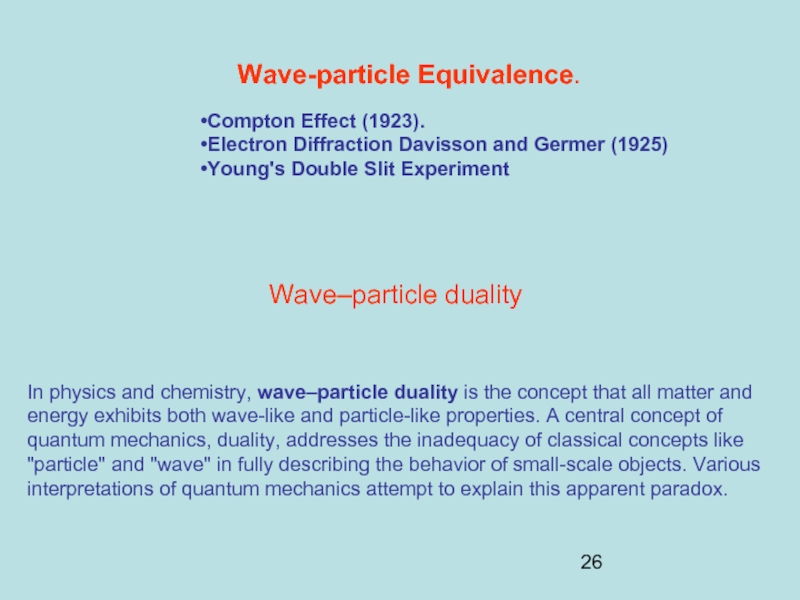
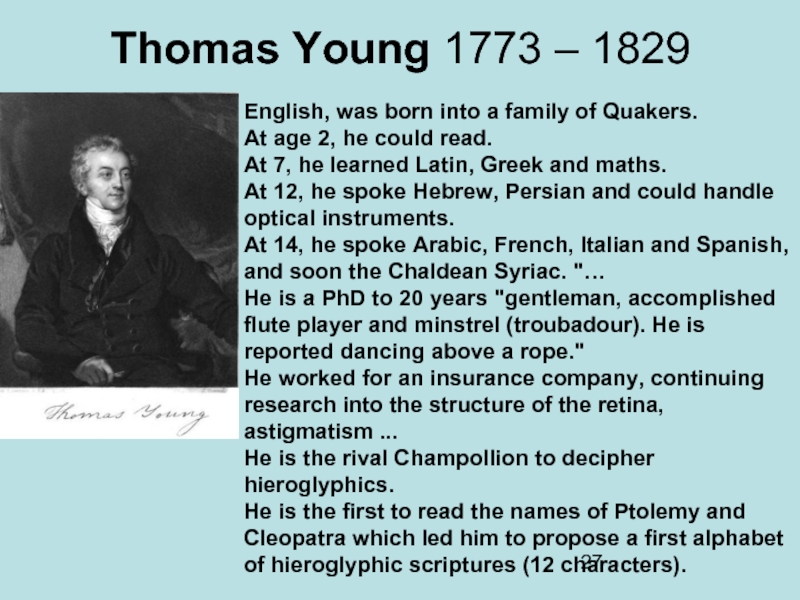
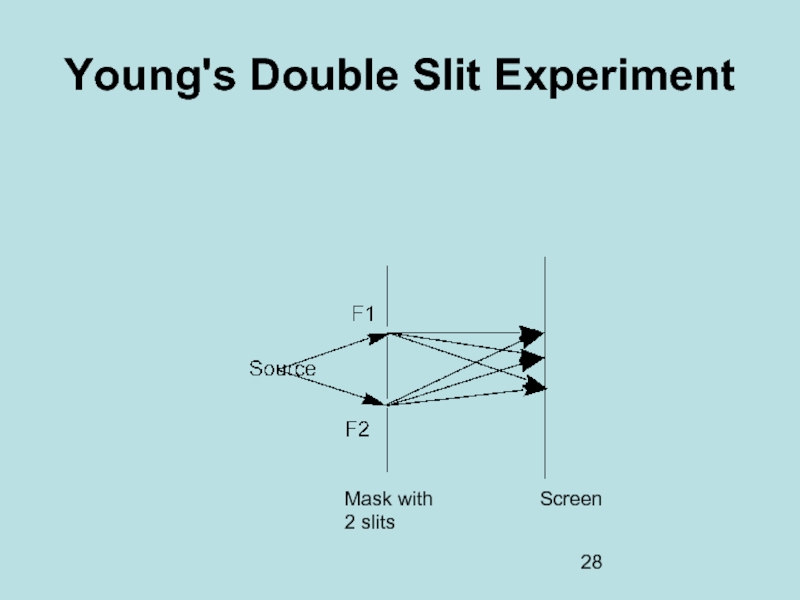
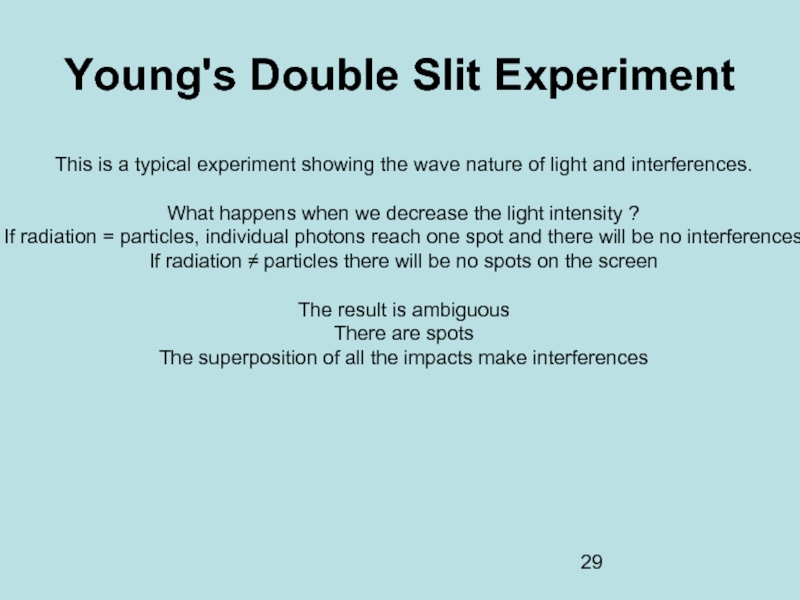
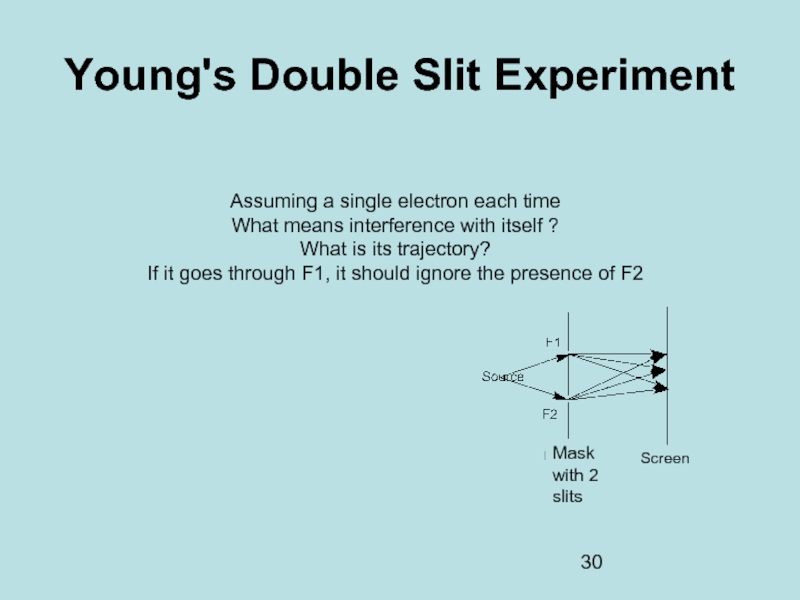
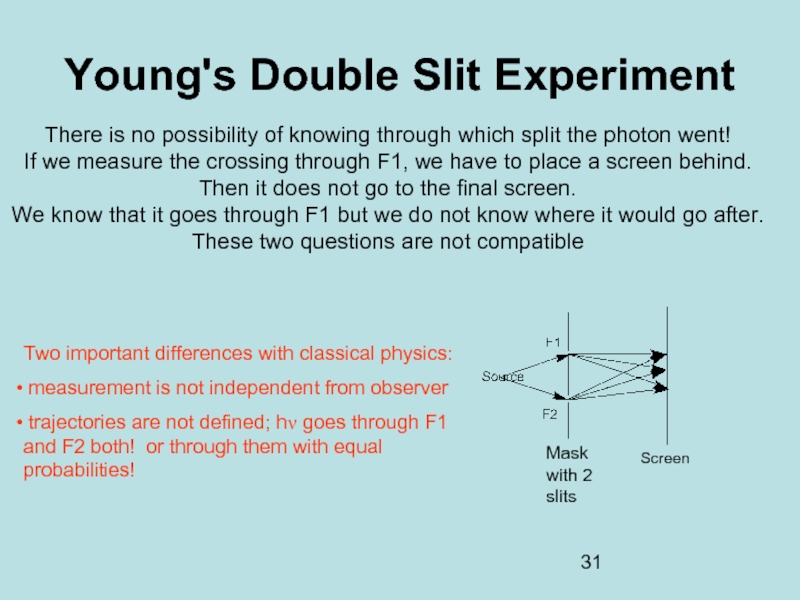
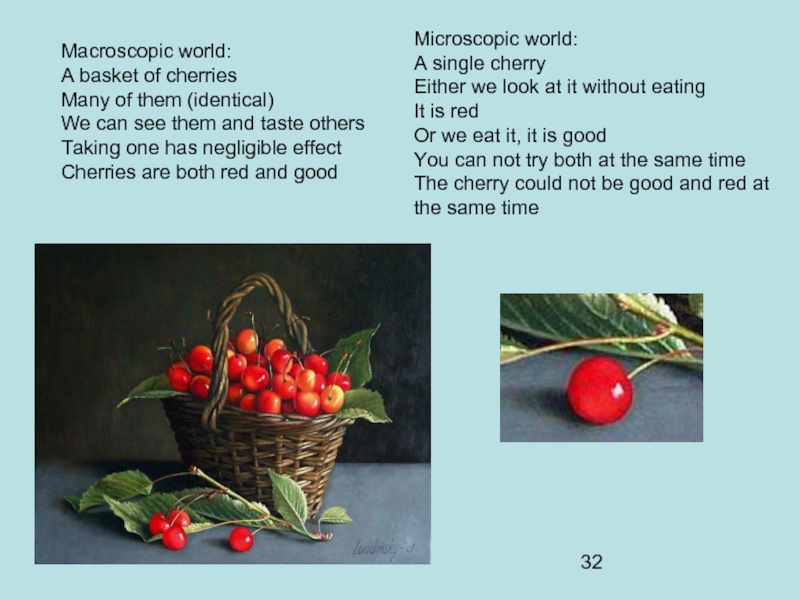

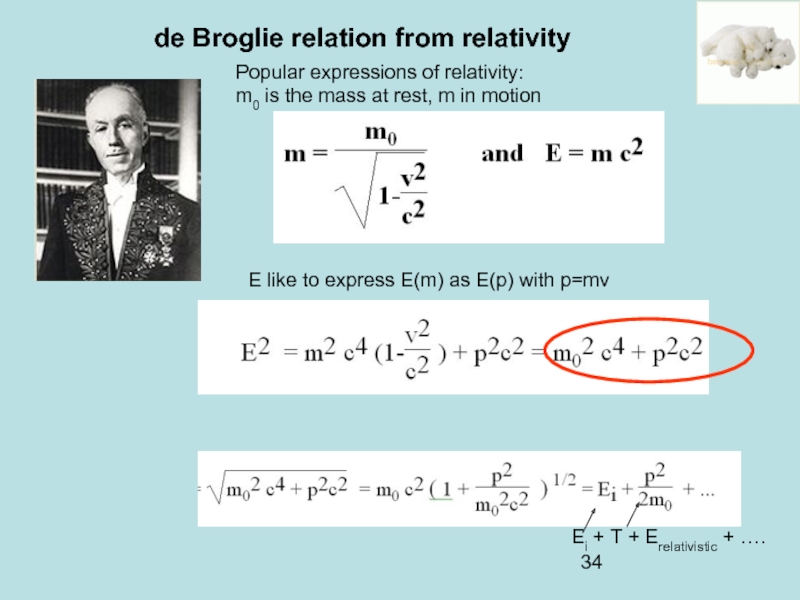
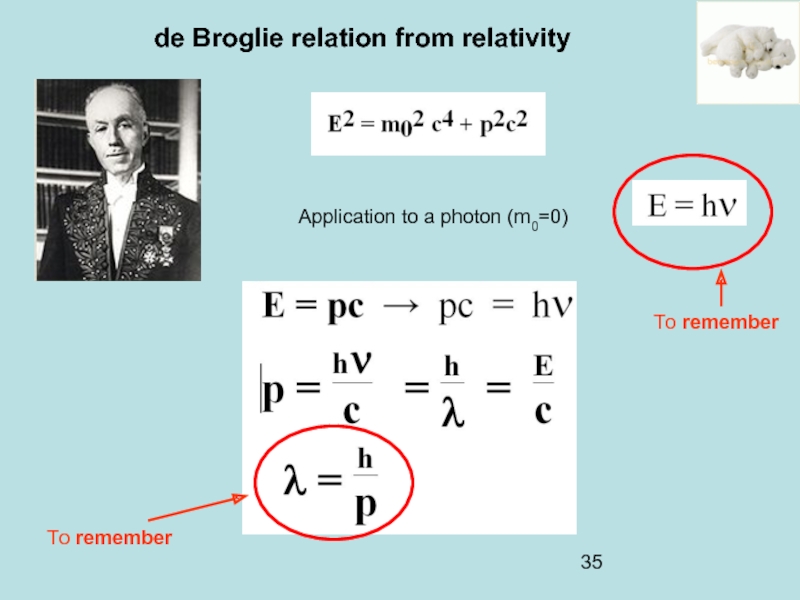
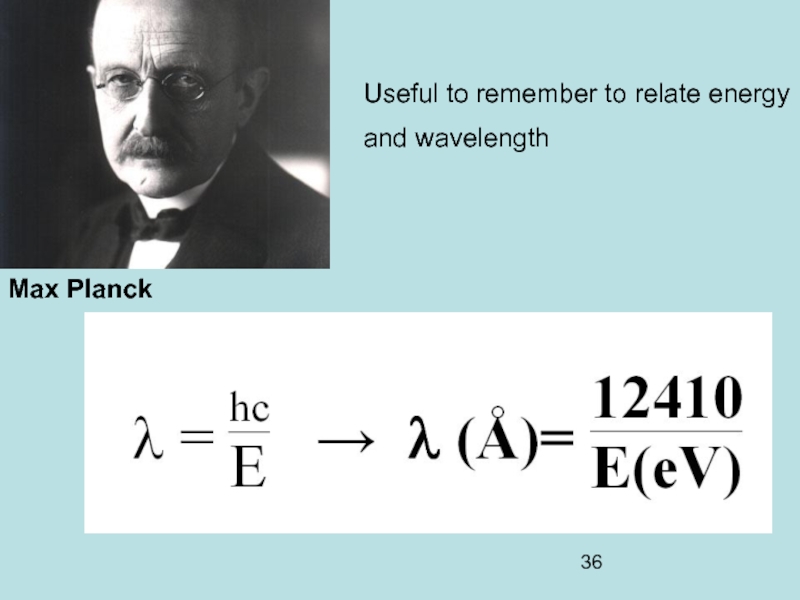
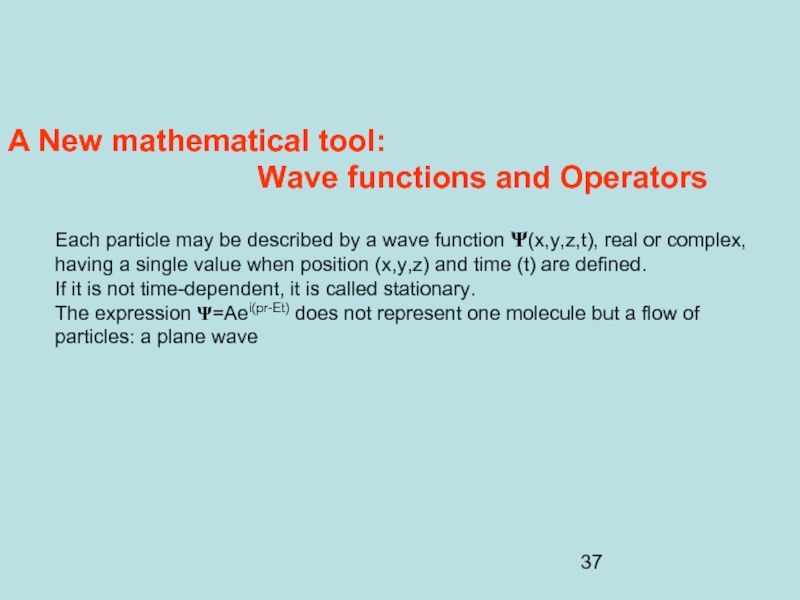
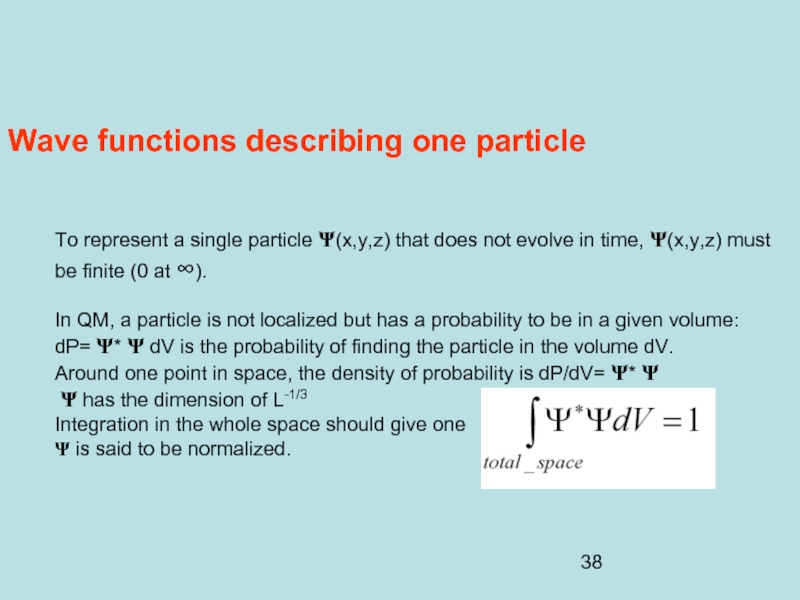
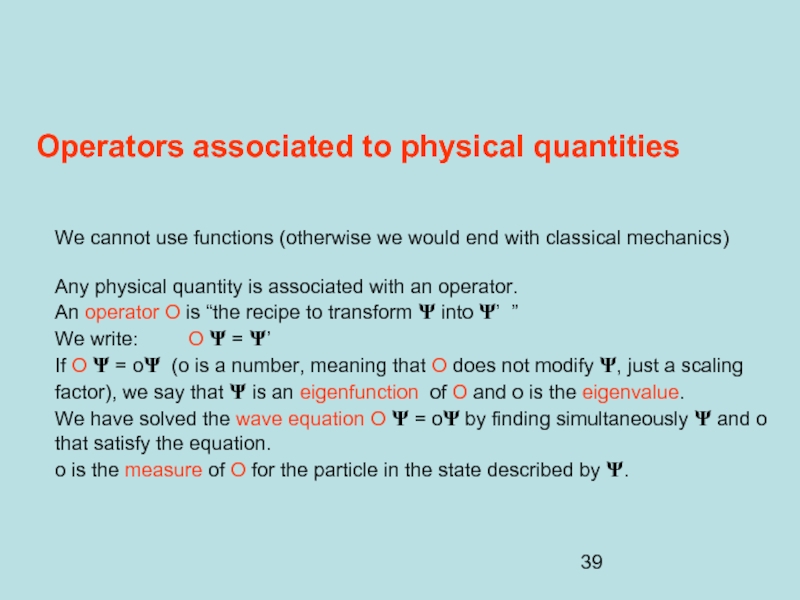
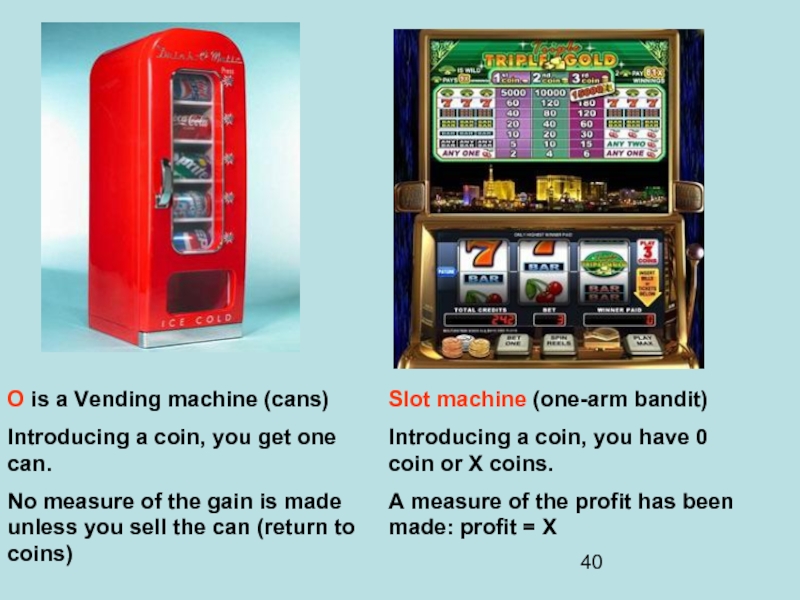
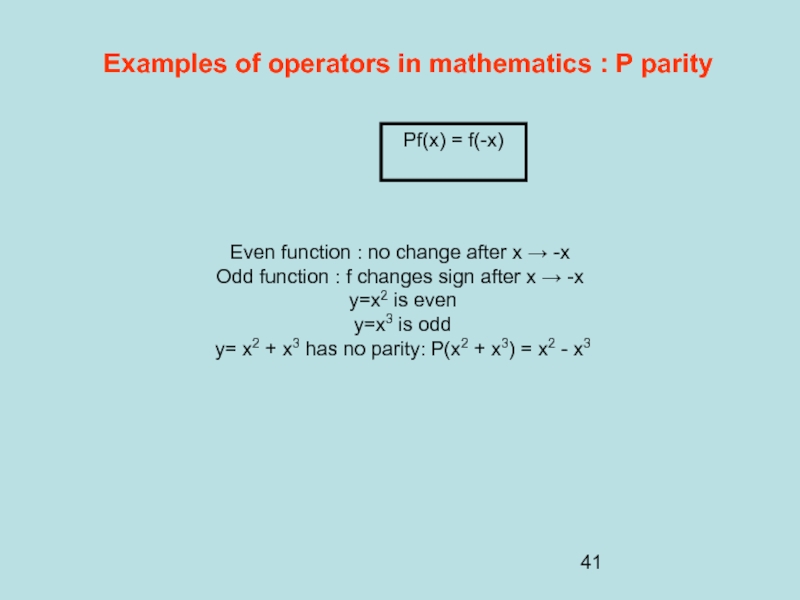
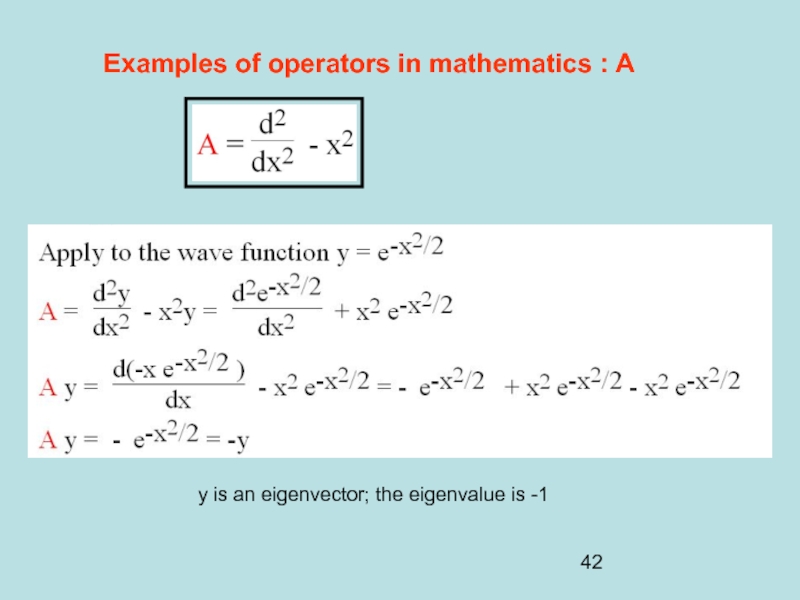
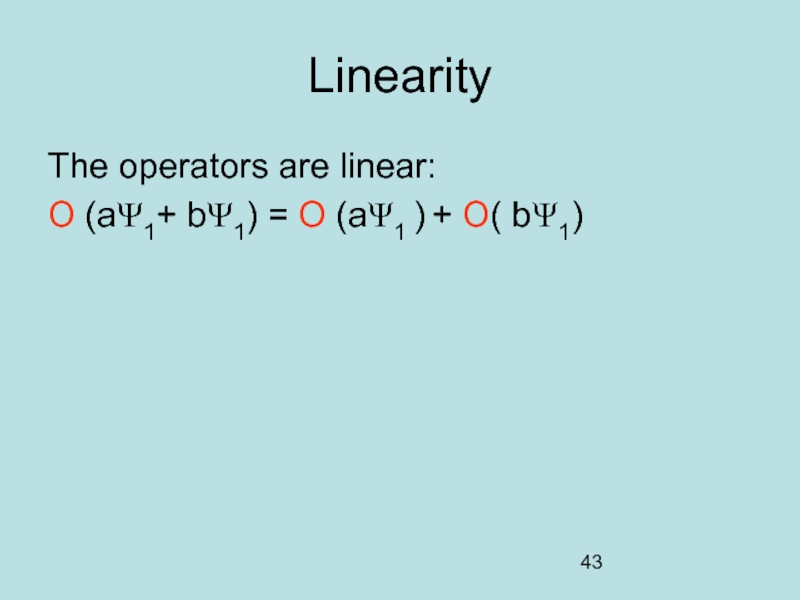
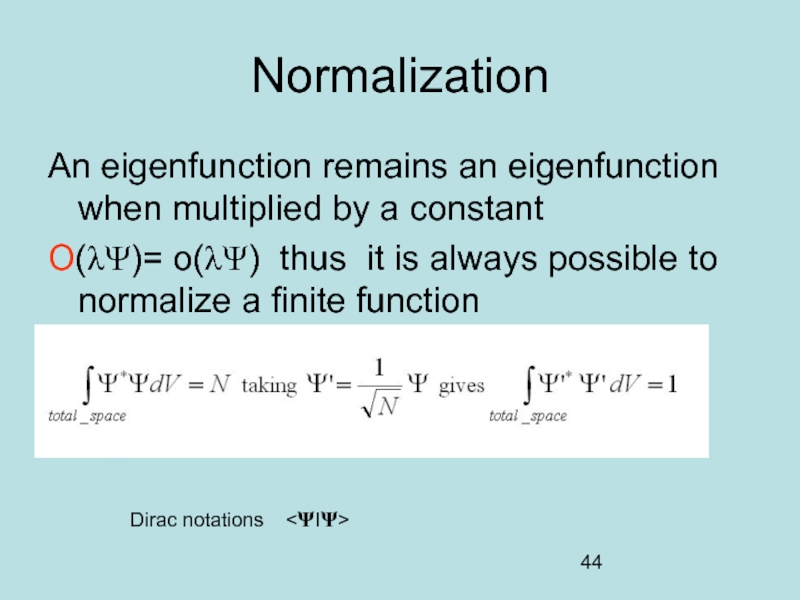
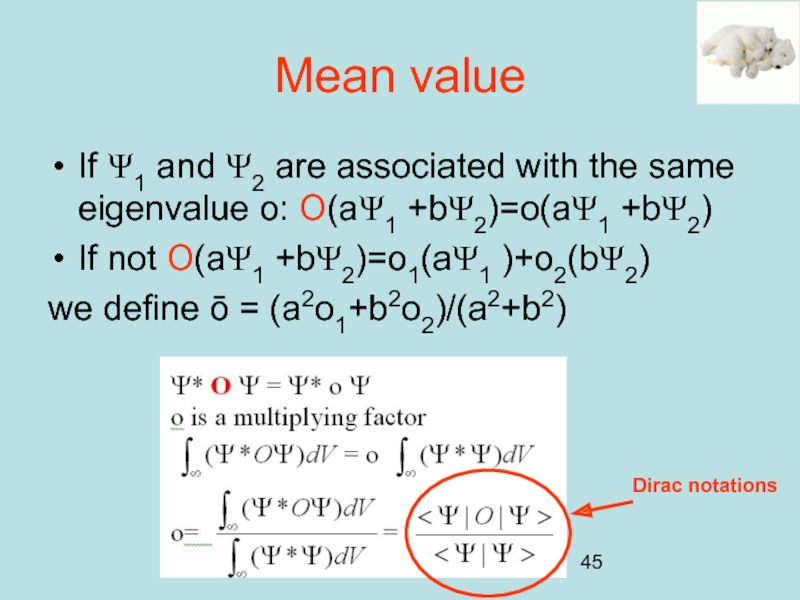
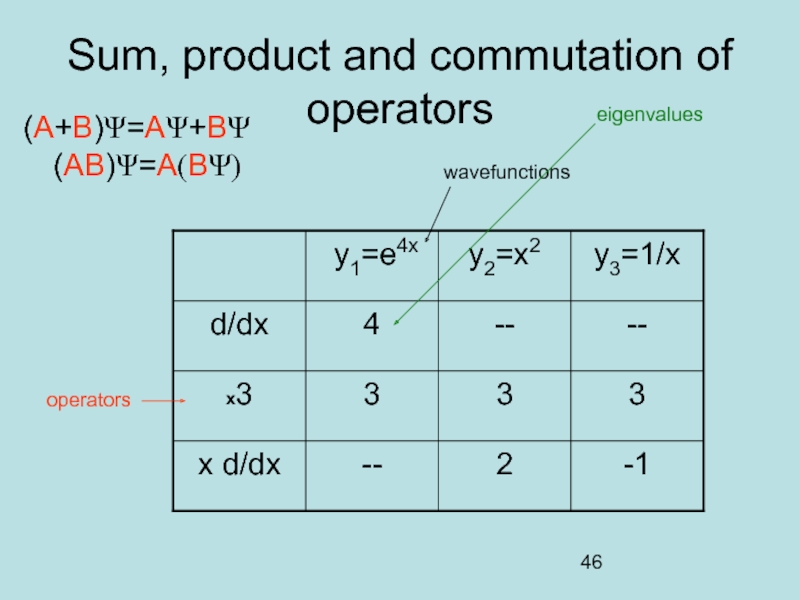
![Sum, product and commutation of operatorsnot compatibleoperators[A,C]=AC-CA≠0[A,B]=AB-BA=0[B,C]=BC-CB=0](/img/tmb/2/163699/0a72379c955e38c7bc2939826c7a35b0-800x.jpg)
![Compatibility, incompatibility of operatorsnot compatibleoperators[A,C]=AC-CA≠0[A,B]=AB-BA=0[B,C]=BC-CB=0When operators commute, the physical quantities may be simultaneously defined (compatibility)When](/img/tmb/2/163699/b8aefd41cdd26ab18ce58dd206690129-800x.jpg)
